The Colt Python has a special kind of gravitas that resonates with many people. It’s revered for its capabilities as a competition gun and a defensive weapon, for hunting, and for sheer enjoyment as a recreational shooter. My generation of peace officers almost universally regarded it as the “Cadillac” of duty revolvers.
The Colt Comeback
Its reputation only grew when Colt ceased its production completely around 2006. Pythons soon became quite collectable and obscenely expensive if you were shopping for a decent shooter.
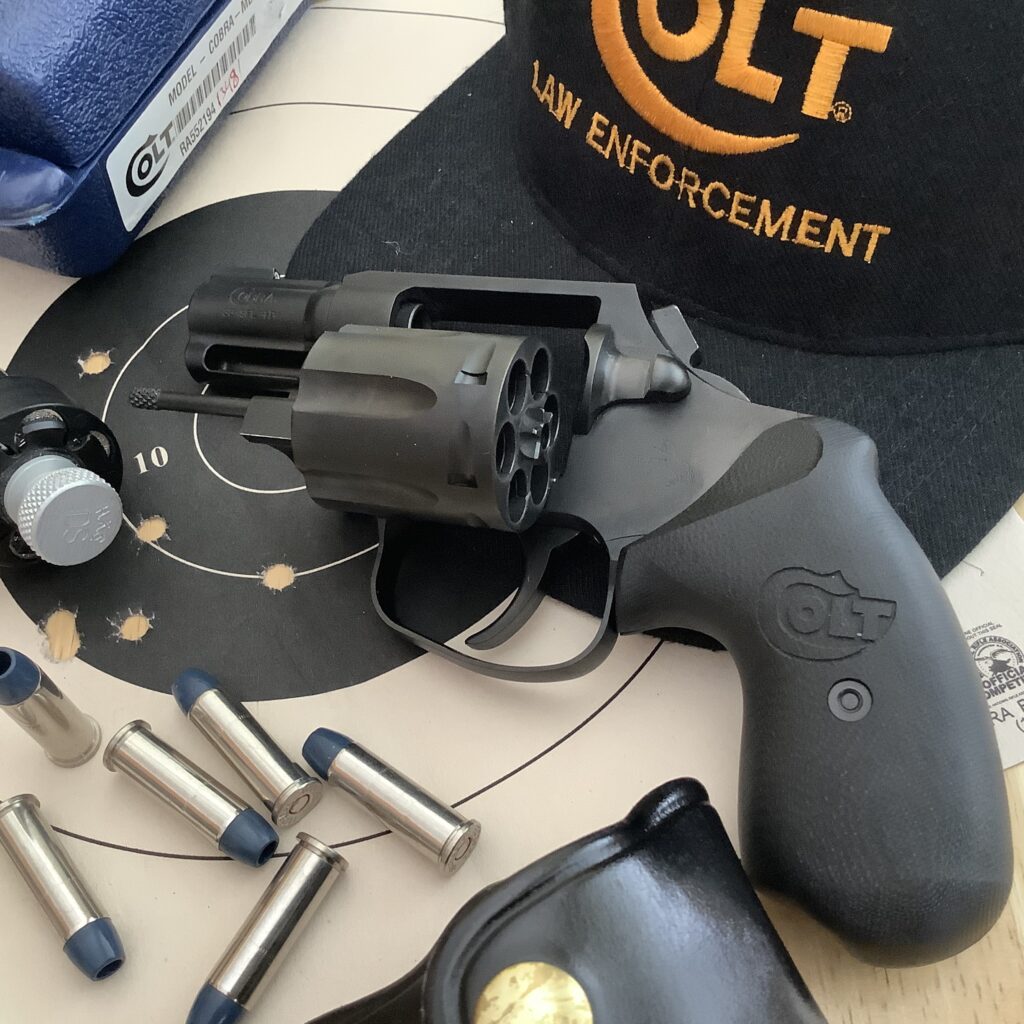
Colt dipped its toes back into the double action revolver market with its redesigned Cobra in 2017. It was a different gun than the original Cobra but was well done and well received. Colt went on to solid success with the new King Cobra in 2019, proving that returning to revolver making was a sound choice.
The Python Returns
The team at Colt had been doing their homework, and by 2020 they were ready to dive in with a new Python. Justin covered it back then, and remarked that when he first heard of the Python’s return, he immediately pictured a blued one.
As they had done with the Cobras before it, the decision makers at Colt opted for stainless steel for the 2020 Python. That was a sound business decision, since bluing carbon steel to the old standard was challenging and cost prohibitive. The stainless gun was attractive and functional, and Colt fans were (for the most part) grateful to have any Python back. Still, there was always the nostalgic hope that Colt would bring one out that looked like the blued steel Python of 1955.
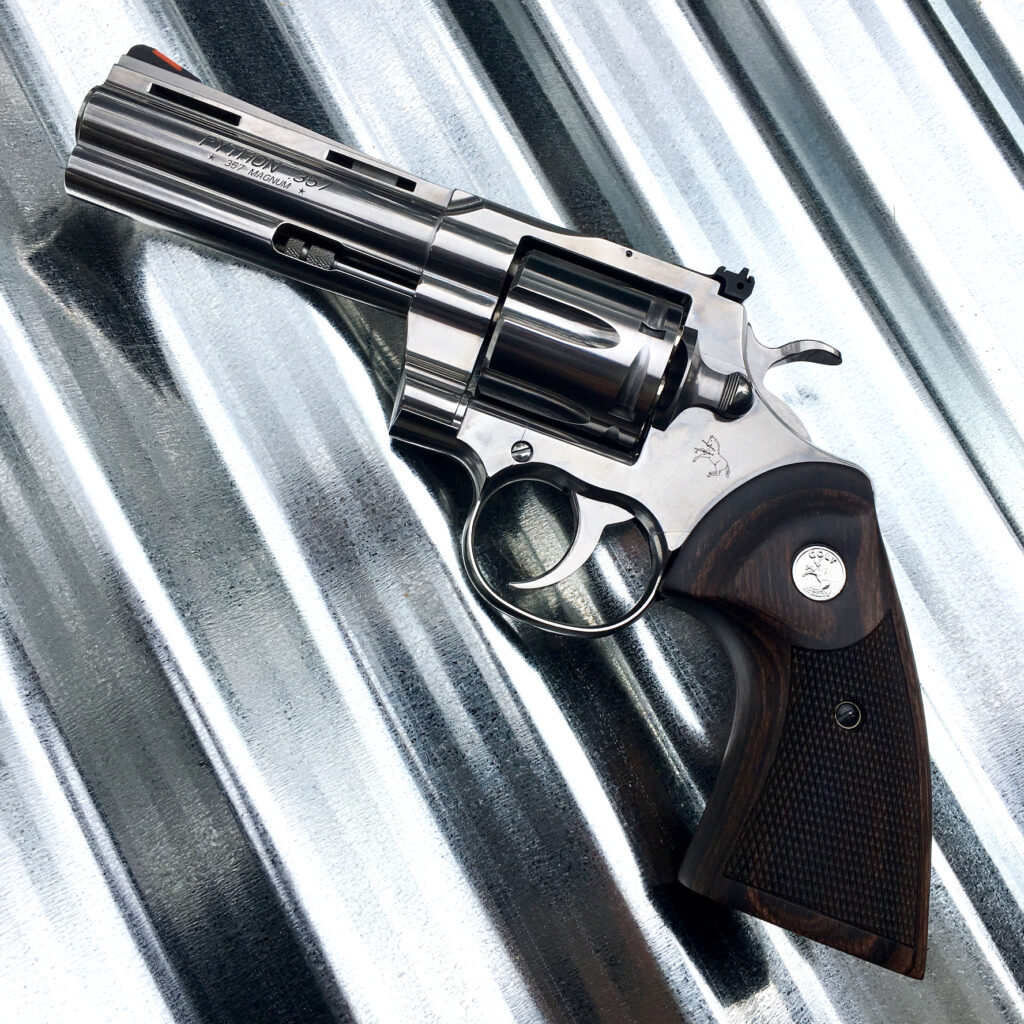
Around SHOT Show this year, Colt acquiesced to customer wishes and honored tradition by bringing its classic back. Mike asked me if I would test one, as months would pass before he’d be legally permitted to possess one in California. That was sort of like asking a lifelong Ford driver to give a Chevy a try. As revolvers go, I had cast my lot with S&W at an early age and never really looked back. I’d shot an original Python here and there, maybe a couple of dozen rounds through the years. Everything works backwards on those Colts, dang it. I pondered it for a long while (like three seconds) before I told Mike I’d do it–because it needed to be done.
The Premiere Snake Gun
As many of you know, the original Python was basically handmade by talented craftsmen employed at Colt in the post-war years. It was immediately popular and swiftly gained the reputation as (arguably) the finest D/A revolver extant in the mid-1950’s. The guns were expertly fitted and polished and wore the royal blue finish that Pythons were known for.
The weak link in the new Colt was its action. It dated to the late 1800’s and was made to function with cartridges that started life loaded with low-pressure black powder. Most folks thumb cocked them and fired in single action for shooting chores back then. Using the same action to send thousands of high-pressure .357 Magnum rounds downrange in double action mode had a tendency to send the Python’s action out of time. It took a gunsmith with some specific skill to smooth the stacking feel of the double action trigger pull, too. There were lots of gunsmiths in the 60’s, 70’s and even the 80’s that could rehab “out of time” Pythons and give them a respectable action job. By the turn of the new millennium, there were precious few ‘smiths still around that had the knowledge to perform that work.
Updates
Colt’s design team was determined to fix the mechanical issues that plagued the original Python before the 2020 version was released. They took their time, and they did it right.
Mike is going to have a detailed look at what makes the gun tick later, so I’ll give you the Cliff’s notes version here. Colt engineers studied the original action, identified weak points, and were successful in strengthening it. The improved action had nine fewer parts, making it easier and less expensive to produce. The leaf mainspring was maintained, but made substantially bigger, and its shape was altered to improve action feel and longevity.
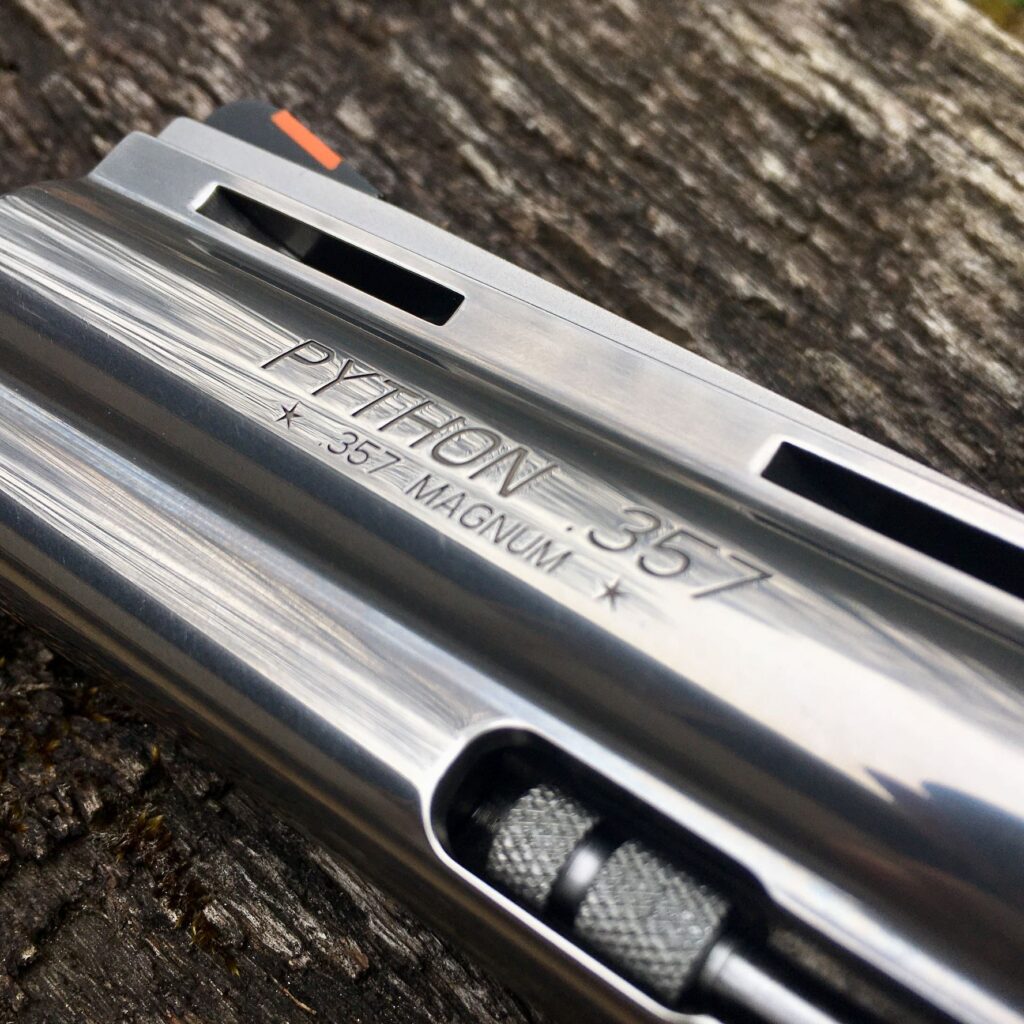
A “cylinder stop” like those found in S&W actions was used to strengthen lock up. The new action allowed for a better (non-stacking) double action trigger pull. It was also much more resistant to going out of time. The action parts were machined from bar stock steel, including the trigger, hammer, and cylinder release. Thirty percent more steel was built into the topstrap–it was blended to make it less noticeable, and maintain the lines of the original. Barrels were forged from solid billet steel as one piece, and milled in steps to form the distinctive vent rib and underlug.
Features
When I removed the big revolver from its packaging, the first thing I noticed was my reflection in the frame. It had been very well polished before the finish was applied. The blue was deep and even, with no visible flaws. It was a shade or two darker than the classic “Royal Blue,” but it was very nicely done.
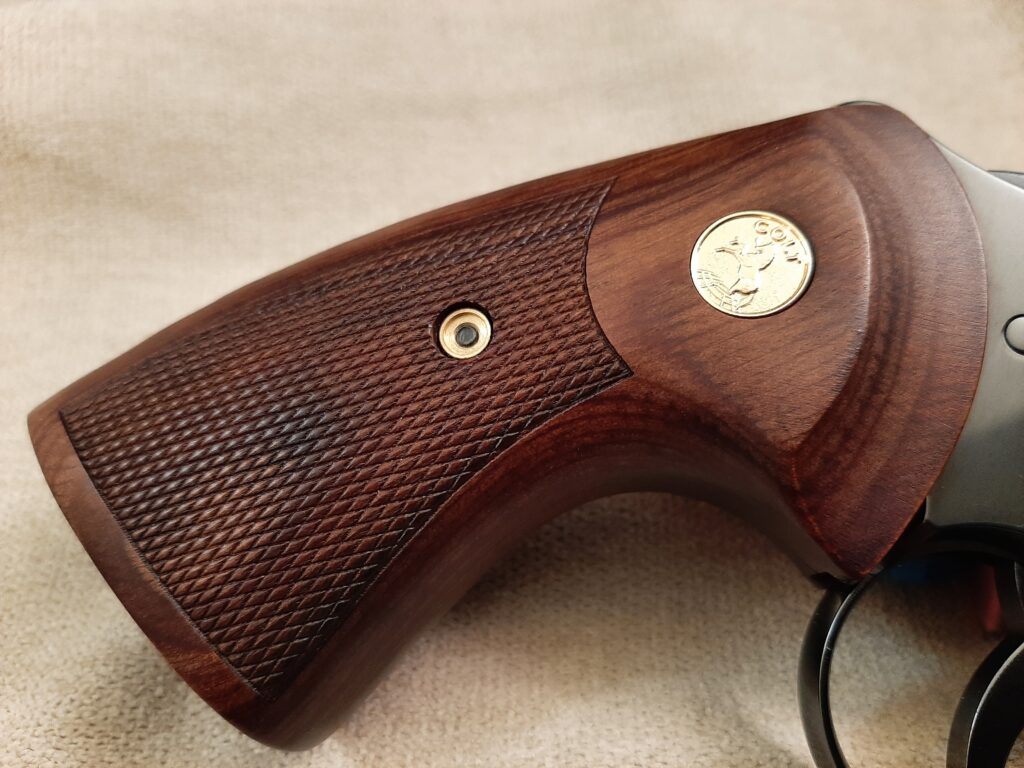
The stocks were reminiscent of the originals, although the flare at the base didn’t look quite as wide as on the old guns. Made by Altamont of a walnut laminate, they fit the frame evenly with no seams or gaps. The checkering was clean, and the rampant pony emblem was gold colored, with the word “Colt” properly centered at 12 o’clock. The sights consisted of a fully adjustable rear (like an improved Elliason) paired with a red ramp front.
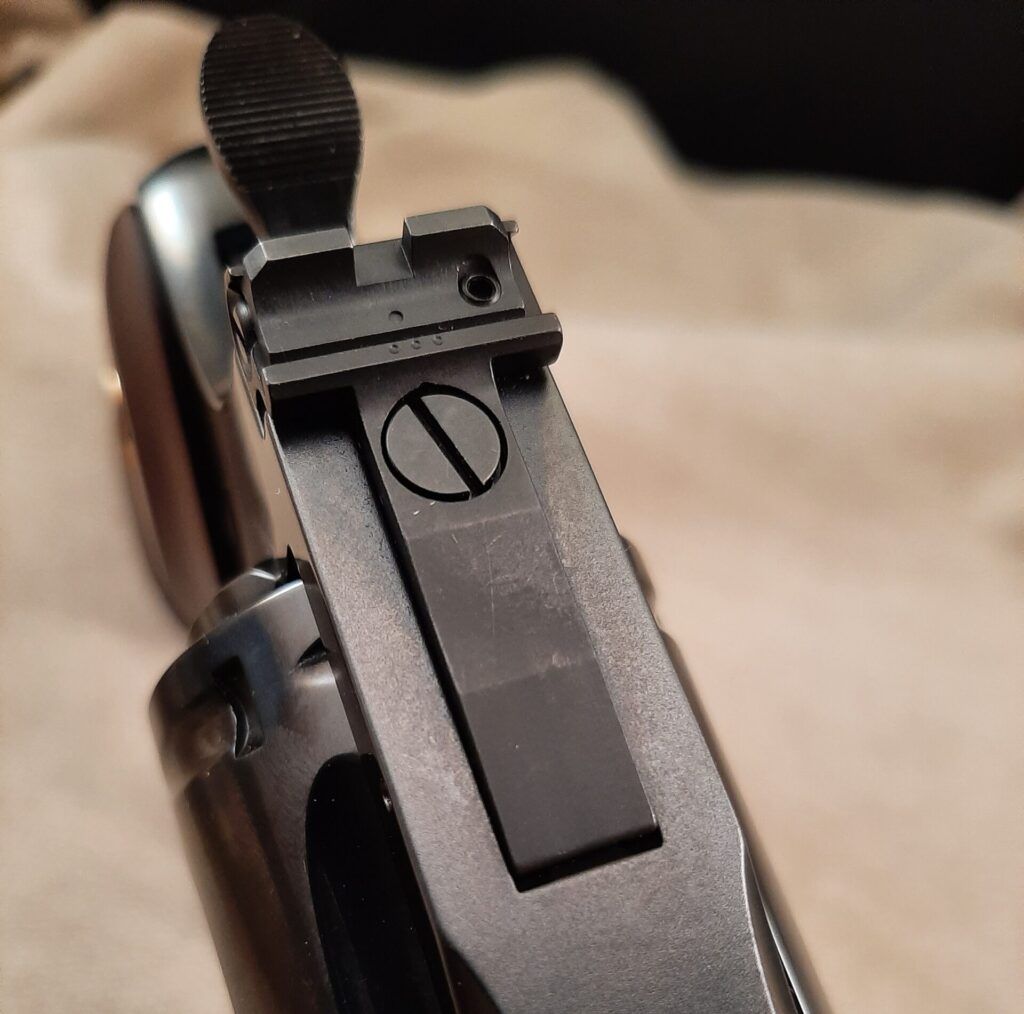
The front sight is easily removeable, and held with a .050 hex head screw that’s accessible from the front. It’s handy in that the Python’s sight can be switched out for front sights made for the Cobra or King Cobra. This makes swapping for a fiber optic, brass bead, or tritium sight very easy.
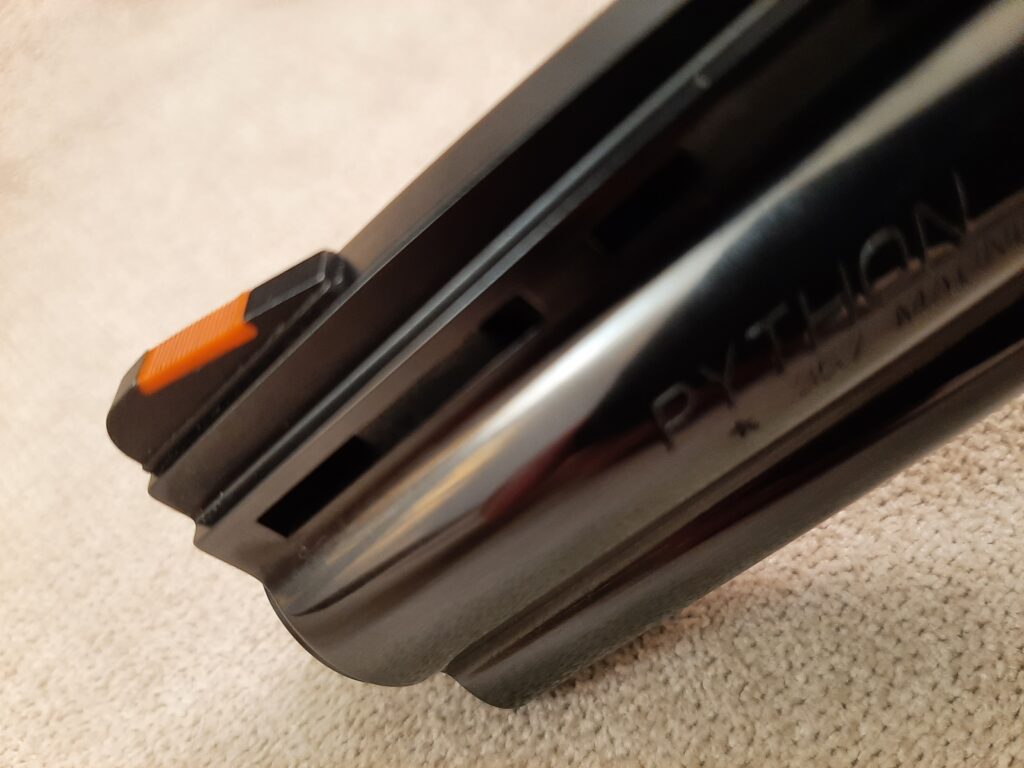
The trigger was of combat width and had three vertical grooves running the entirety of its face. I prefer a smooth-faced trigger, and I was curious how this one would perform in live fire.
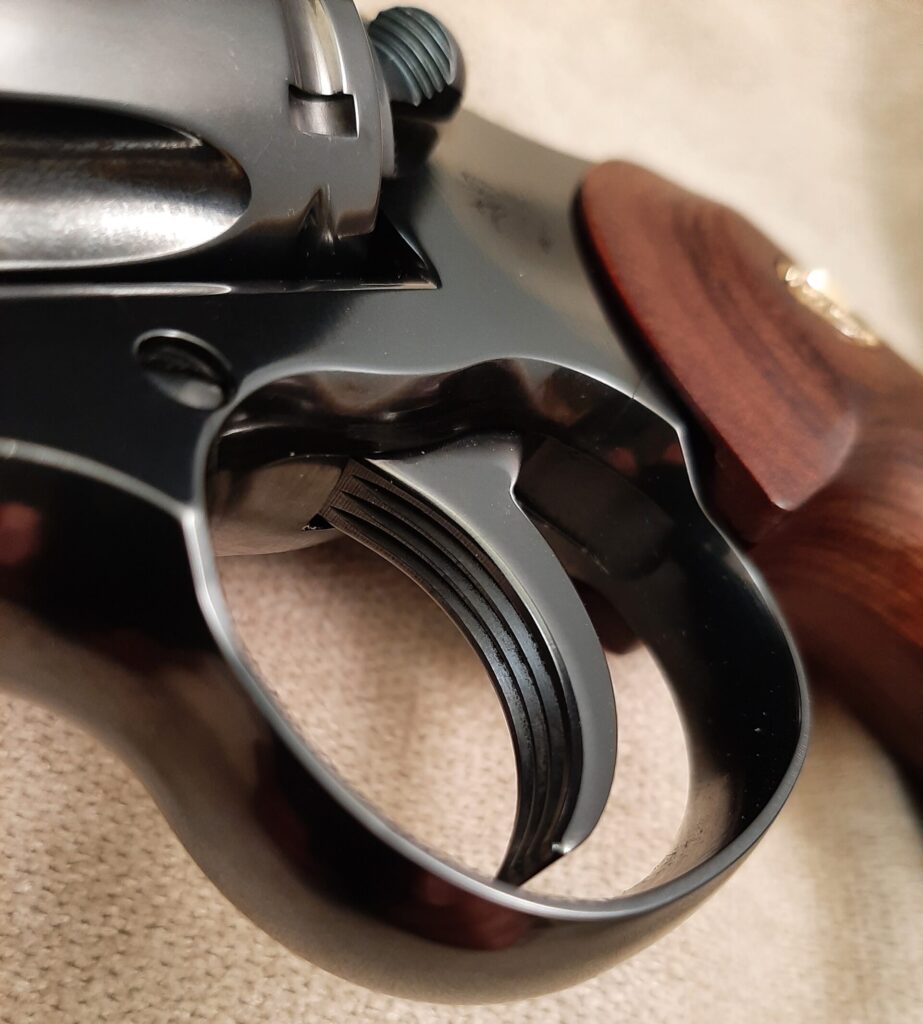
The hammer spur had sharp lateral serrations in place of checkering that gave positive purchase. The firing pin was frame-mounted and a transfer bar protected it from unintended ignition.
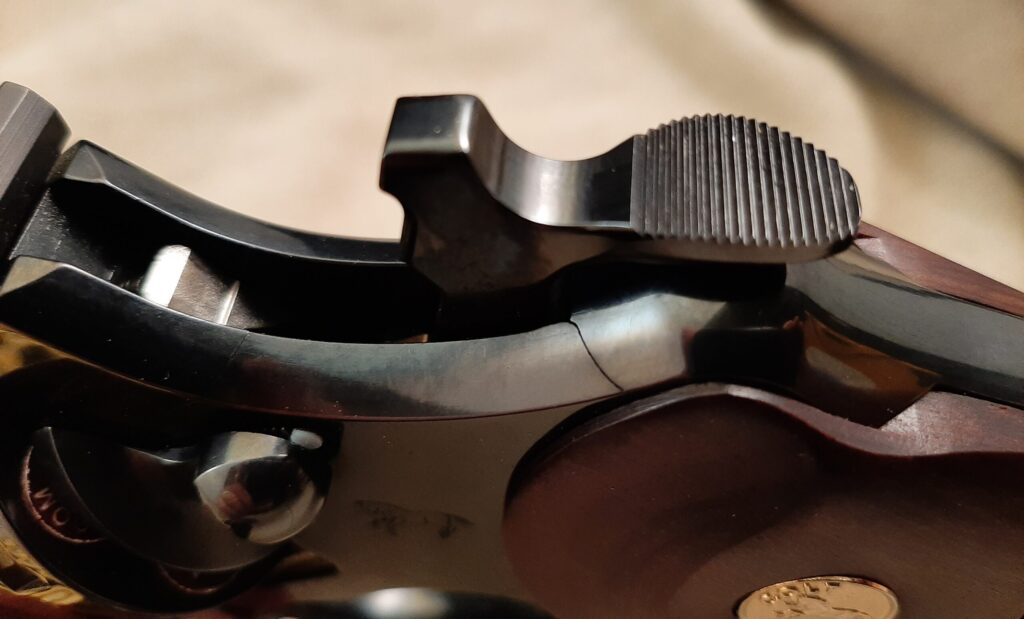
Studying the profile of the gun, the screws on the frame underneath the cylinder were further forward than on the original. Adding a cylinder stop to the action mandated that. The raised cylinder lug (left side, lower rear corner of cylinder window) on the side plate that kept the cylinder from traveling too far rearward was also deleted.
Fit and Function
Opening the cylinder revealed the smooth function and movement of the release, the crane, and the ejector rod. Everything felt solid and… finished. Like they were paying attention when they put it together. The barrel cylinder gap looked minimal and even on all chambers. I don’t have a set of gauges, but daylight was hard to find in the gap.
Checking the lock up revealed no lateral movement in the cylinder. This was consistent around the cylinder’s orbit. The cylinder was snug fore and aft as well, with no detectable end shake. I cannot remember the last time I felt a double action revolver with a lock up this exceptional.
Presenting the Python in a two-handed grasp to a firing position, the gun had a slight muzzle-heavy balance compared to a S&W Model 19 or skinny-barreled Mountain Gun. It even felt like it leaned more forward than a S&W Model 686 with a similar barrel profile.
Pressing the trigger through in double action mode yielded a smooth travel that barely disturbed the sight picture upon breaking. Cocking the gun and pressing the trigger single action revealed a pleasingly crisp break with just a touch of movement before the hammer released. The Python had an impressive trigger straight out of the box. The D/A trigger pull measured 9 pounds, 9 ounces on the average. The S/A pull broke at 5 pounds, 6 ounces.
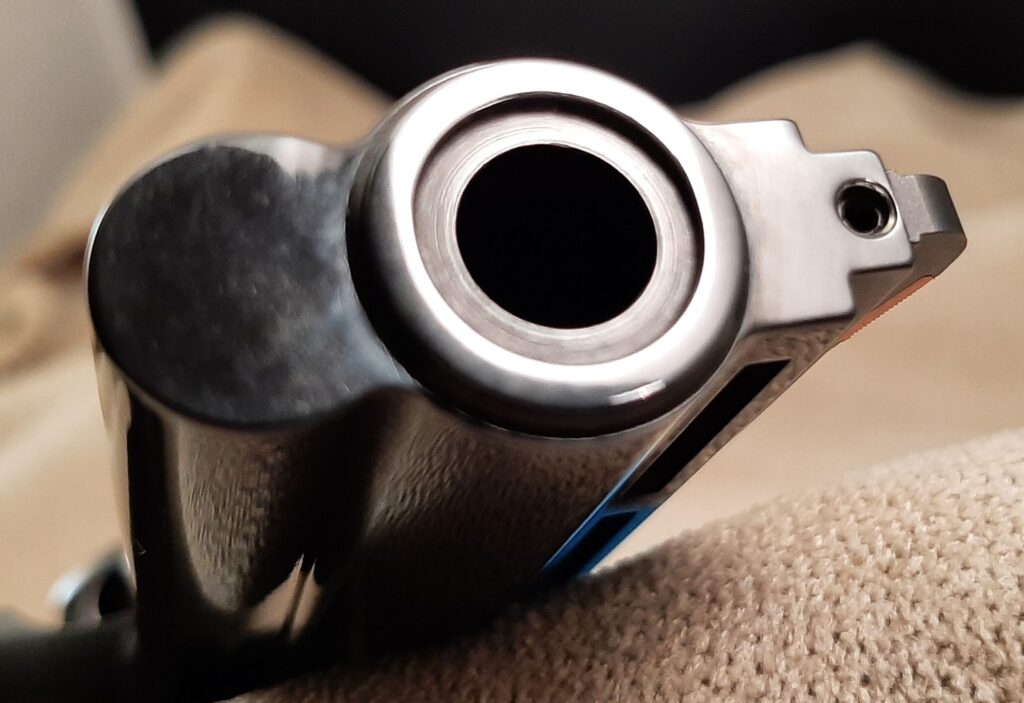
The muzzle had a raised ring of metal to protect the rifling crown; the top of the frame and vent rib were matte finished to cut glare between the sights. The blued Python made a good first impression on me, it was a thoroughly handsome revolver.
Shots Fired
I started live fire with some Remington .38 +P 125 gr Golden Saber HP’s. Easing up the recoil spectrum seemed prudent with the Altamont’s’ open backstrap design. The .38’s were pleasant, so some 125 grain Golden Saber .357’s were fired. This load is one of the best “mid-range” carry loads available; It’s given excellent results in other revolvers. It averaged 1299 fps, had good accuracy, and the felt recoil was quite controllable.
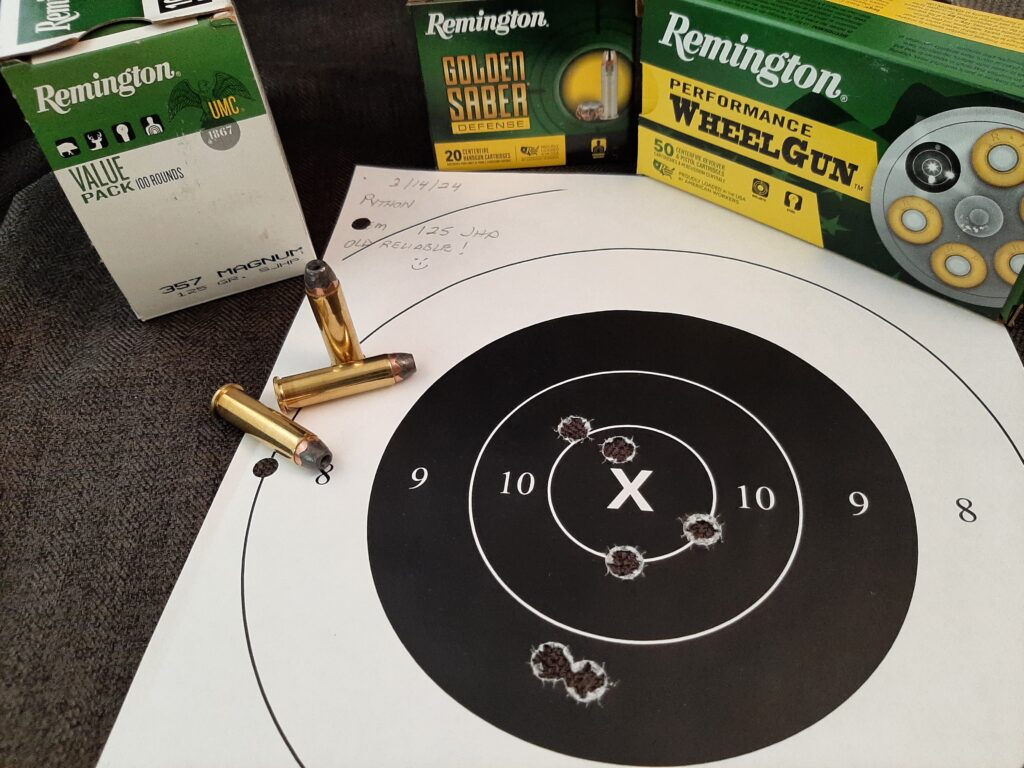
I then shot some of Remington HTP 125 grain Semi Jacketed Hollow Points. That round was loaded to showcase the power of the .357 Magnum. Given the moniker “Blue Flamer” by none other than Clint Smith, it contributed greatly to the fearsome reputation of the .357 Magnum as a defensive cartridge. Along with its power, it supplied full value recoil and muzzle blast to the shooter torching them off. The way the Python handled this round surprised me. It wasn’t painful to shoot, the shape of the backstrap allowed the gun to roll up in my hand instead of smacking it. I had to concentrate on maintaining firm pressure with all my fingers to keep from having to adjust my grasp.
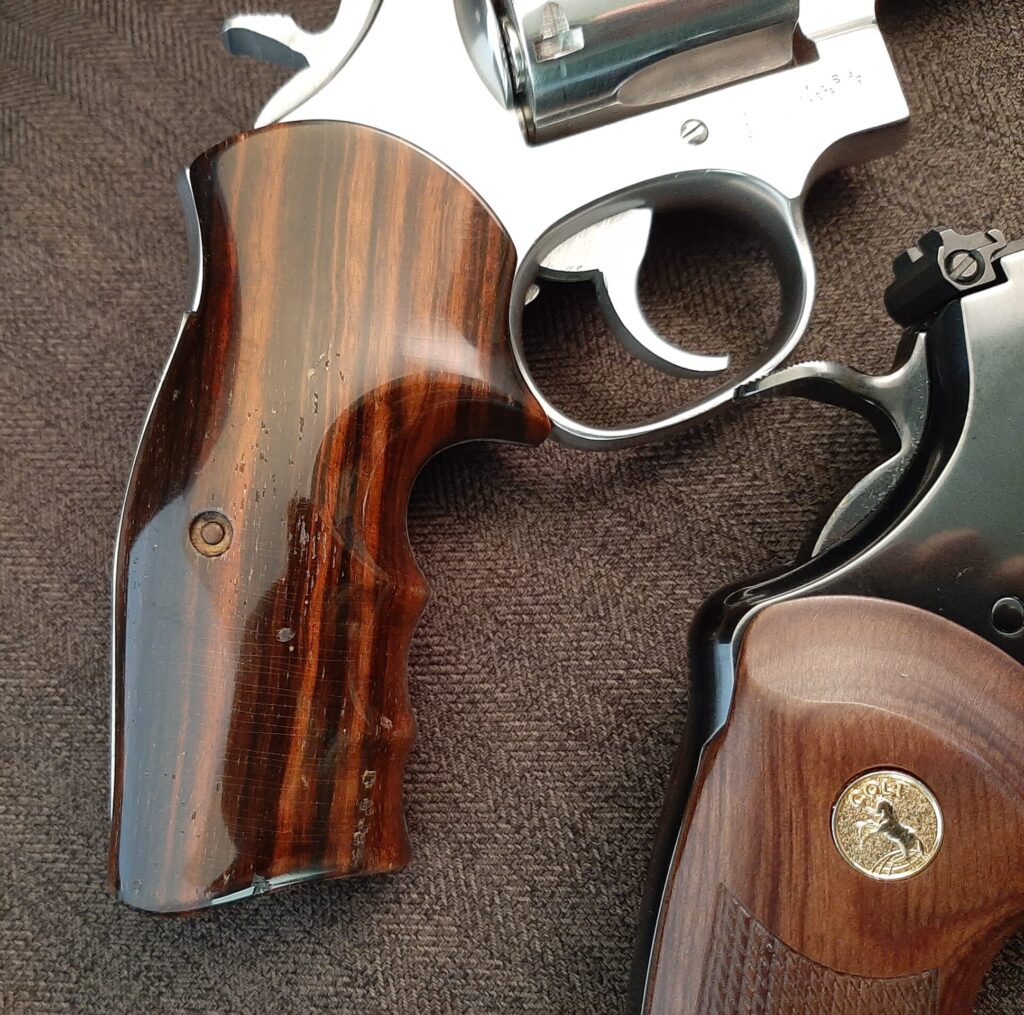
The “hump” of the grip’s back strap is sloped and less severe than on an S&W. It made the Altamont stocks more comfortable than the factory target stocks on a 686, for example. Covering the backstrap with soft rubber isn’t a necessity with the Colt. The muzzle heavy feel combined nicely with the shape of the backstrap to make magnums reasonable to shoot. The Remington SJHP stayed true to its roots and gave an average velocity of 1,536 fps–impressive velocity from a 4.25” barrel. Sixty rounds were fired on the maiden voyage.
More Range Time
The Python was taken, almost as an afterthought, on a trip to the range to shoot some rifles with my son. The winds were awful that day and got worse on our drive. We ended up having to cut our rifle work short, but the trip was salvaged by shooting the Python at steel targets from 10-50 yards. We put an enjoyable 87 rounds through it, predominantly .38’s.
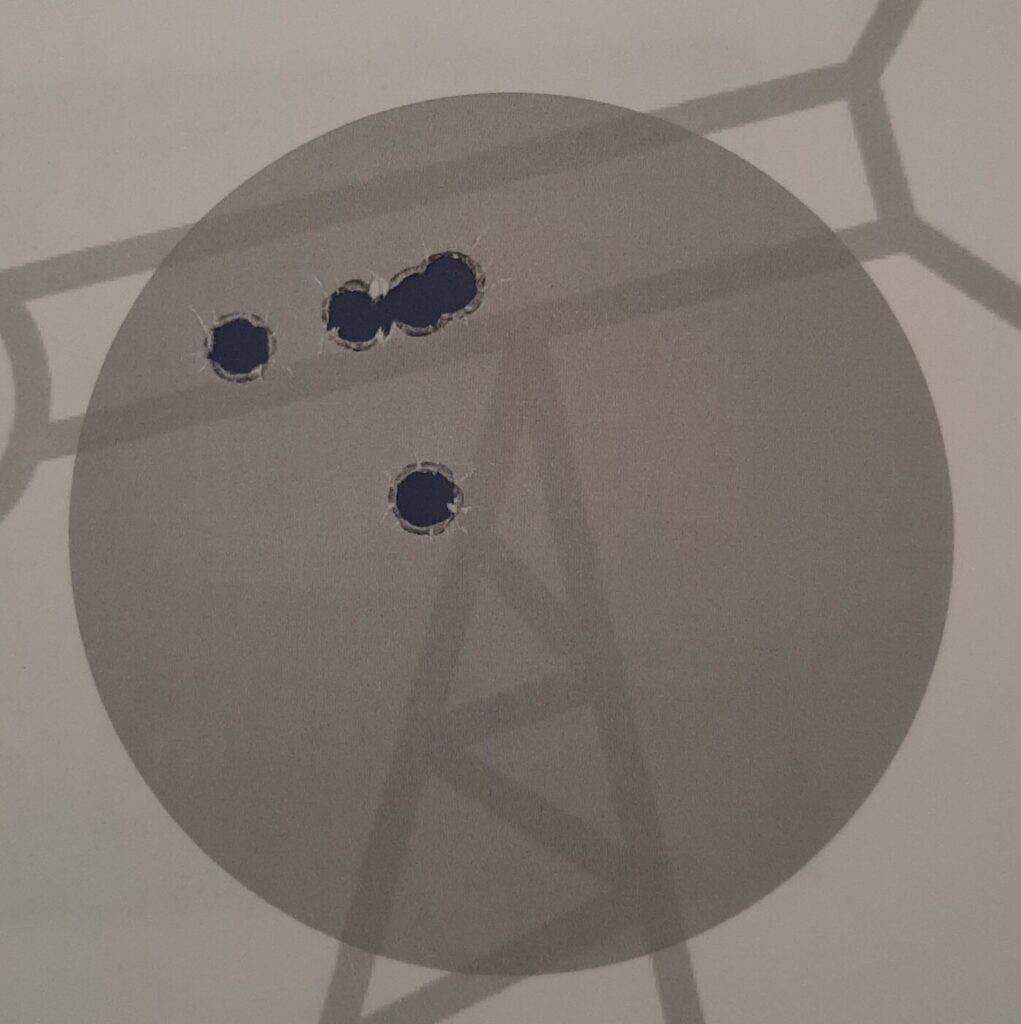
The next time out, I gathered velocity data with more .38 and .357 jacketed bullet loads. The Python shot 125 grain .357 JHP’s well but seemed to favor the first 158 grain load fired, Federal’s JSP. I gave the rear sight a few clicks of upward elevation adjustment to bring the 158’s to point of aim. The “clicks” were just that, you could hear and feel the gradients of movement positively. The Python was shooting a bit left for me, so I loosened the set screw on top of the rear blade with a .050 hex wrench and drew the rear sight slightly Starboard with a small screwdriver. The windage screw gave smooth travel with no clicks. There are witness marks on the top that allow you to gauge the amount of movement dialed in. The set screw was cinched back down when the desired movement was achieved.
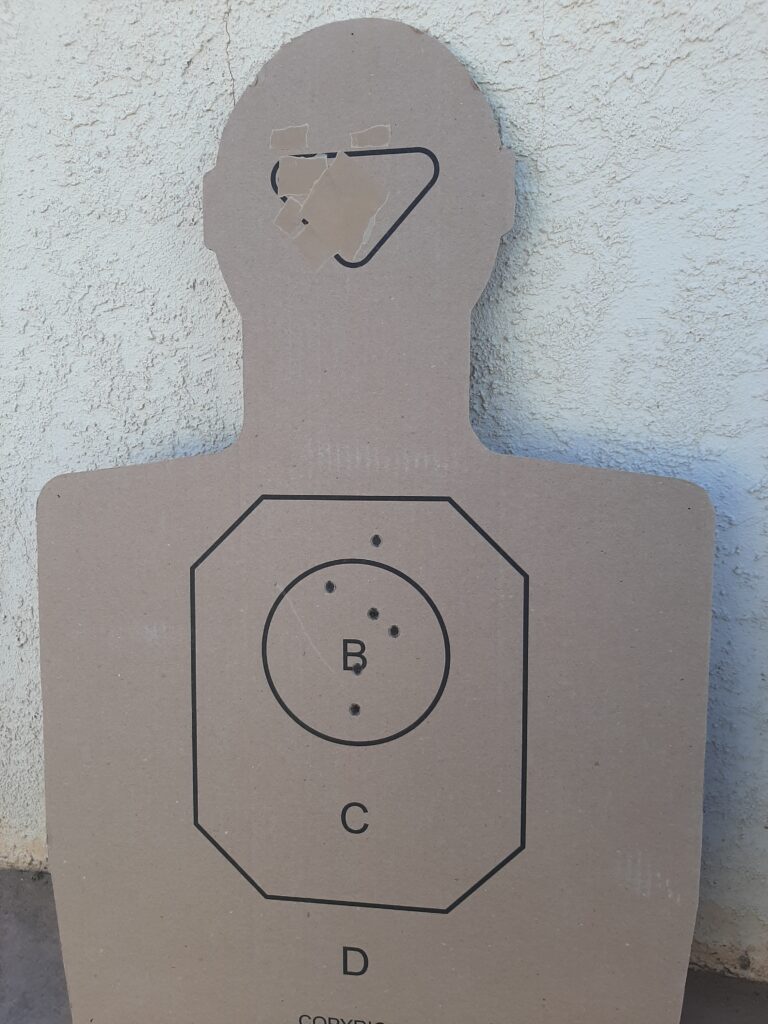
The Python then put the 158’s pleasingly to point of aim at 25 yards. I paced back to the 50-yard line and went prone. I fired six of the 158’s to the body of an IDPA target double action as rapidly as I could acquire a good sight picture between shots. The rounds went to the point of aim in a group that was less than 2” wide and about 4 ½” tall. The day was finished by plinking with Remington match wadcutters–low recoil double action therapy.
Shooting Impressions
With 132 rounds fired that day (72 of them Magnums) I was able to make a few observations. The grooves on the trigger weren’t oppressive–I forgot about them when I was shooting. Felt recoil wasn’t painful, regardless of the load. I did experience some stiffness in my shooting hand for a few days afterward, but that seems to come with the territory these days. It was no worse with the Colt than other handguns.
The Python made me use perfect technique to eject empties or it would occasionally allow one or two to hang around. It was nearly perfect with .38’s if I didn’t get lazy. Brass cased .357 Magnums in the dirty chambers were the most challenging to jettison. In fairness to the Colt, it had received almost no maintenance to that point, only a quick brushing underneath the extractor before my son and I shot it. It had fired 279 rounds in dusty, windy conditions–the muzzle wore a fine coat of carbon fouling that extended back about an inch.
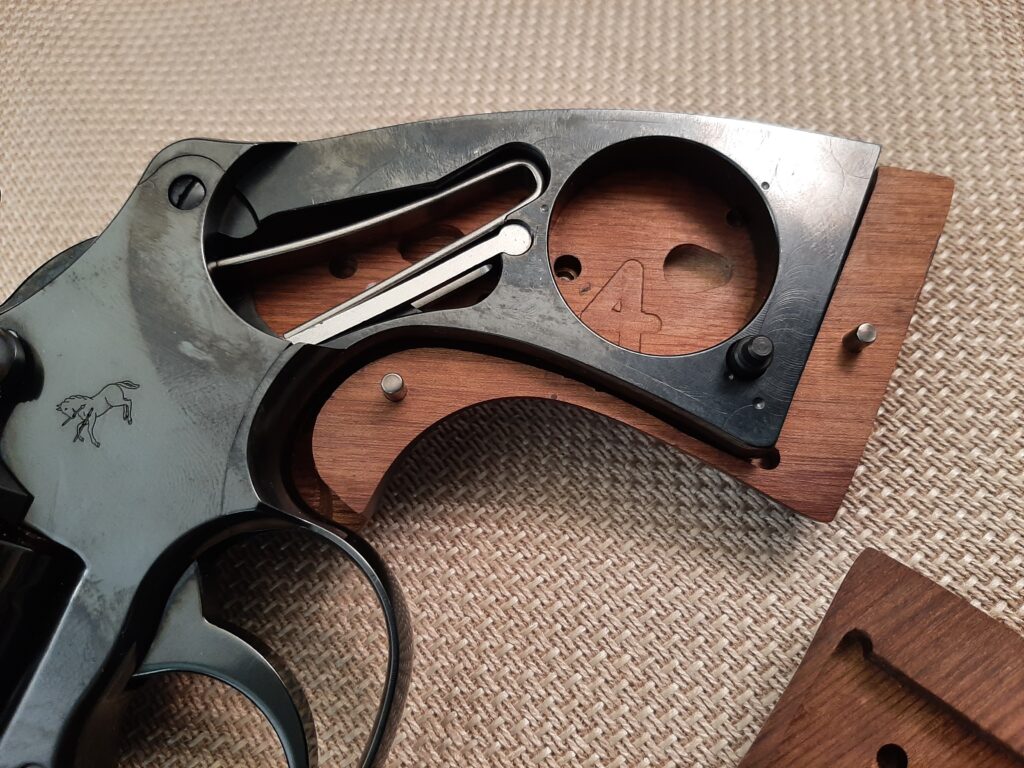
I gave it a cleaning at that point. Removing the Altamont stocks revealed the snug fit and the locator pins used. That explained the complete lack of shifting or wiggle in the stocks. The fine polishing beneath the bluing seemed to make carbon removal easier, the Python cleaned up to look like a new gun.
By The Numbers
The next few trips were dedicated to gathering velocities and assessing the practical accuracy potential of the gun.
Wiley Clap wrote a feature in the American Rifleman on the new Python in April of 2020; if you want Ransom Rested group data, refer to his article. He tested original and new stainless Pythons in both barrel lengths. He showed that the Pythons (all of them) were capable of amazing intrinsic accuracy.
I shot groups from offhand and field supported positions and came away very pleased with how the new Python shot. It would generally keep six rounds in an inch and a half to two inches, standing offhand at fifteen yards, whether I was shooting match wadcutter or Magnum fire breathers. From a prone position, or perched on a stadium seat cushion, most loads held two to three inches at 25 yards. I shot a few single action groups at twenty-five; They tended to be better than double action groups, but not by a great margin.
The tightest group achieved that day came from the Federal 158 grain JSP fired single action from prone on a shooting mat; Rounds impacted in a cluster just larger than one inch. The Python’s barrel has a 1/14” twist, and it stabilized a wide range of bullet weights (125-200 grain) well. It seemed to produce the best accuracy with heavier bullets.
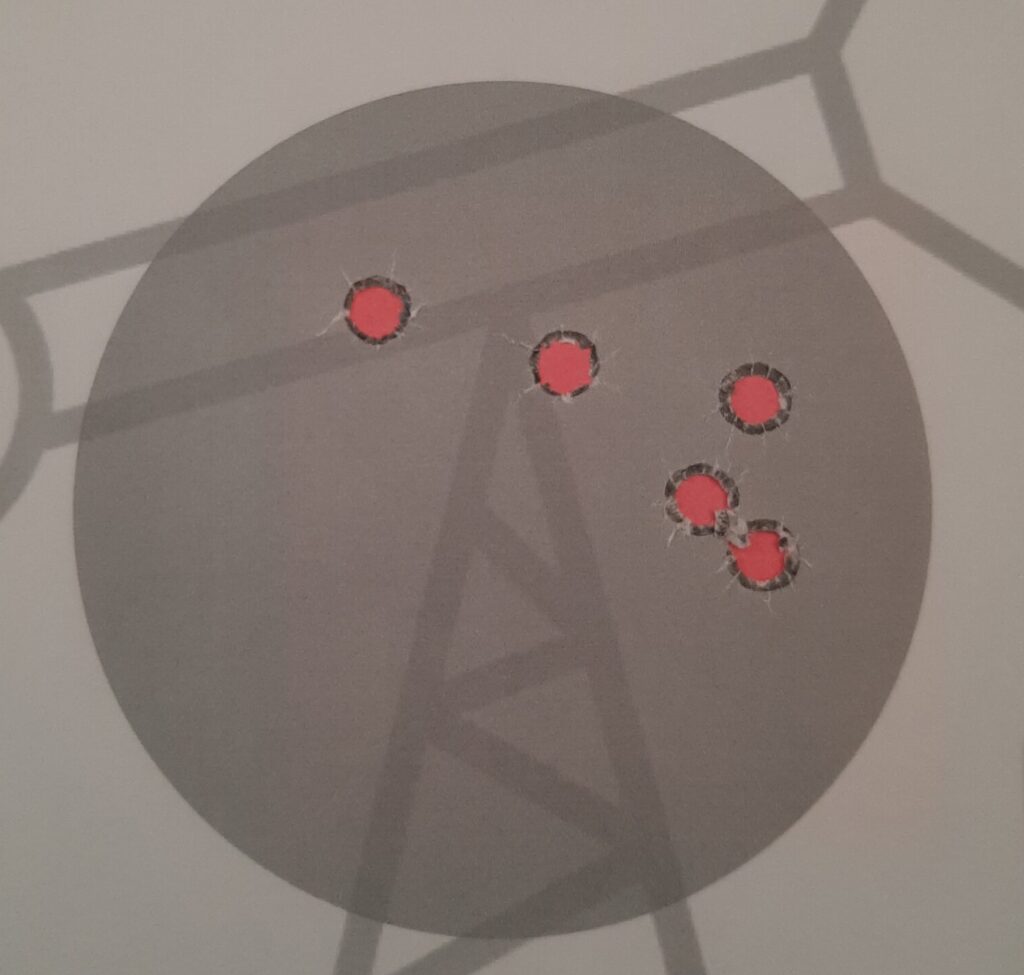
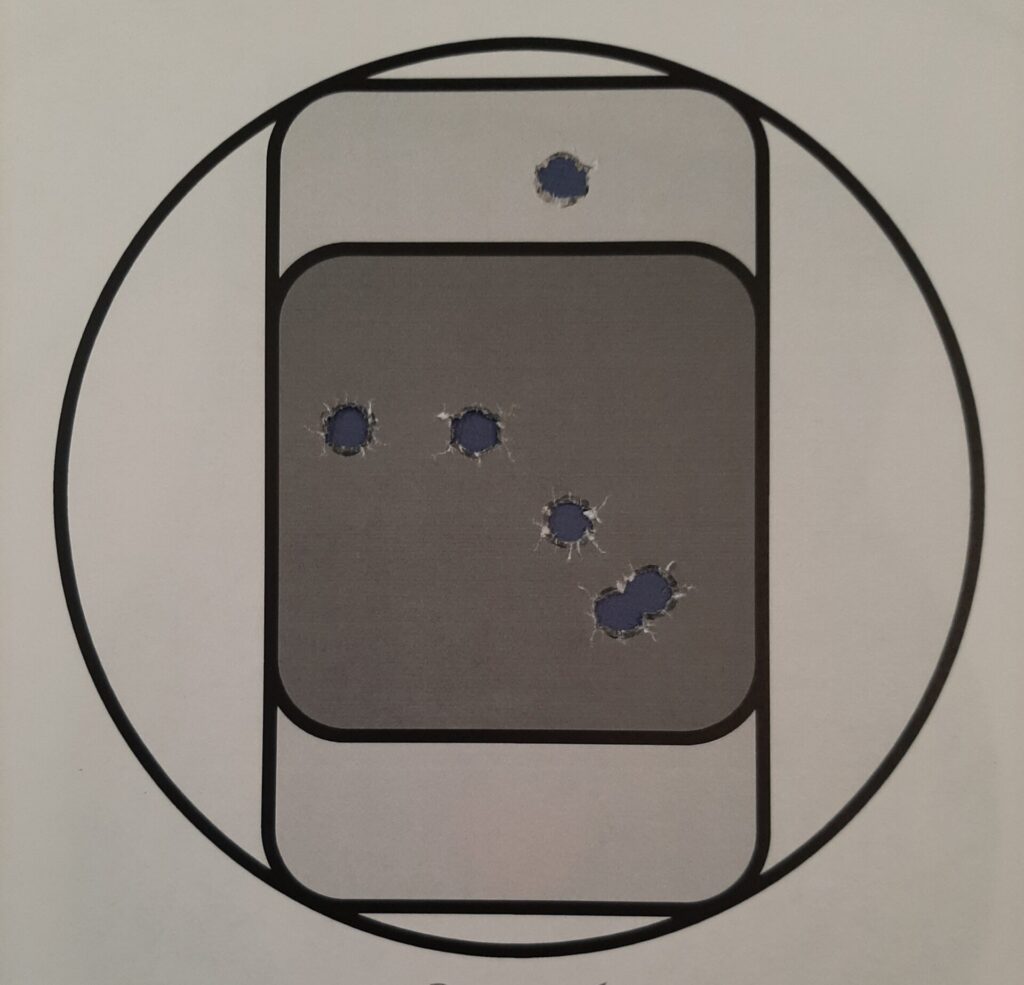
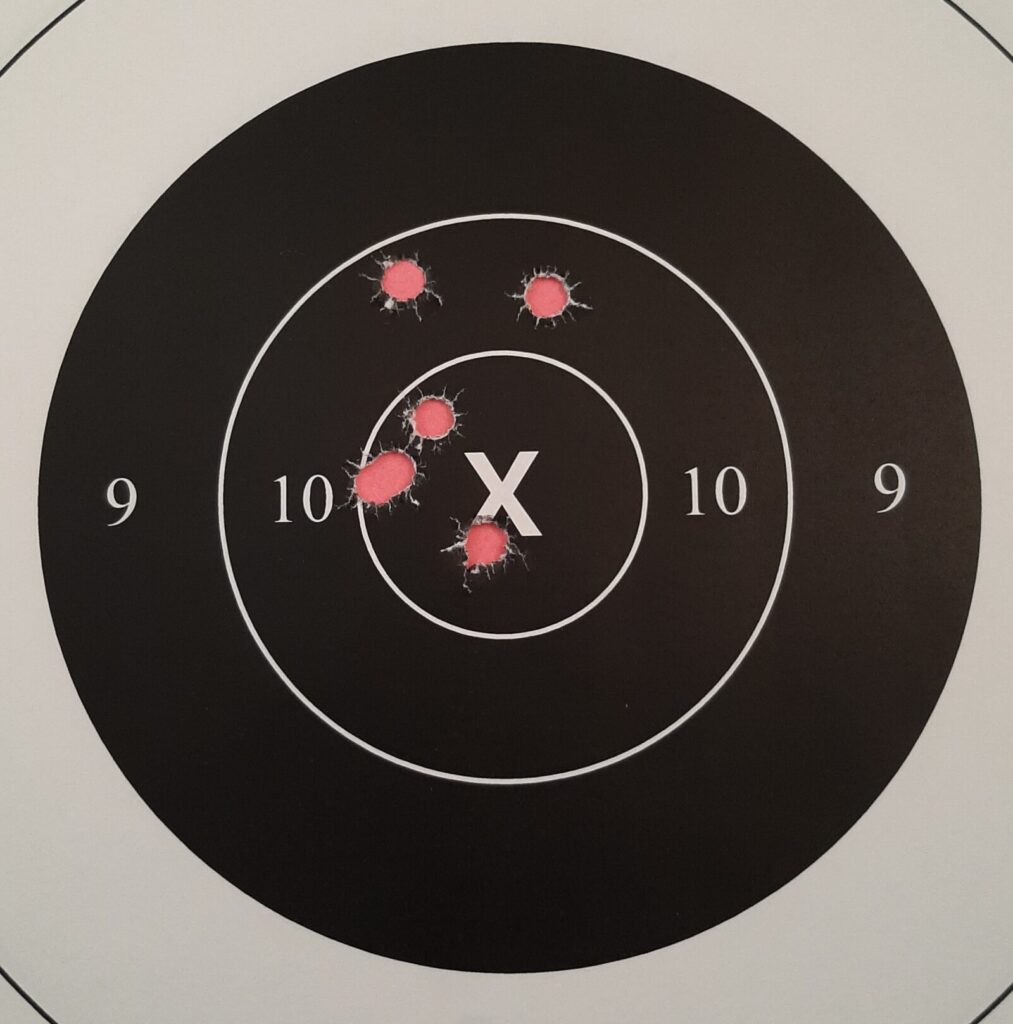
The only round that it didn’t like was CorBon’s .357 Magnum 100 grain Pow’RBall. It shot a disappointing group with a flyer that stretched it to “barely on B-8 paper” from 15 yards.
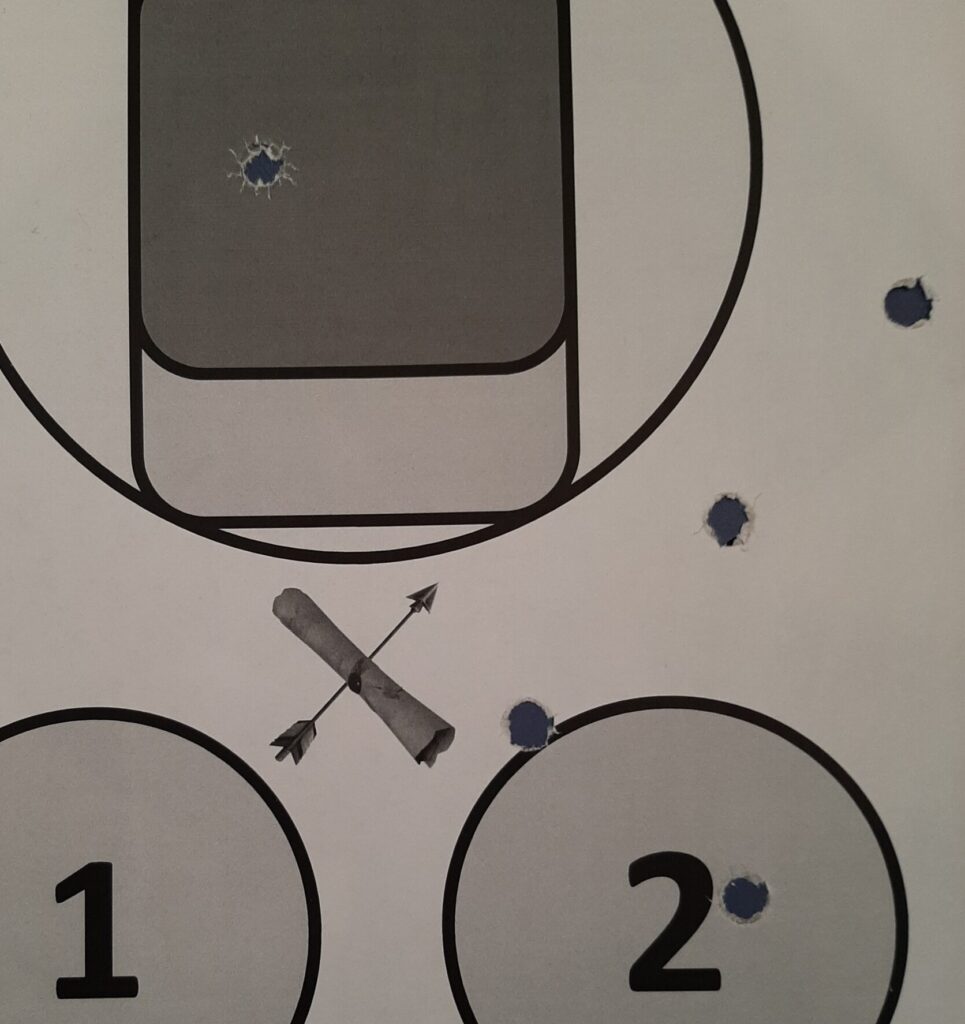
A few loads from Doubletap Ammo proved especially noteworthy. Doubletap Ammo provides “Colt Defense”ammo for Colt; the 158 grain JHP must take advantage of modern powders (or ballistic voodoo), as it produced velocities you’d expect from 125 grain bullets, averaging 1420 fps.
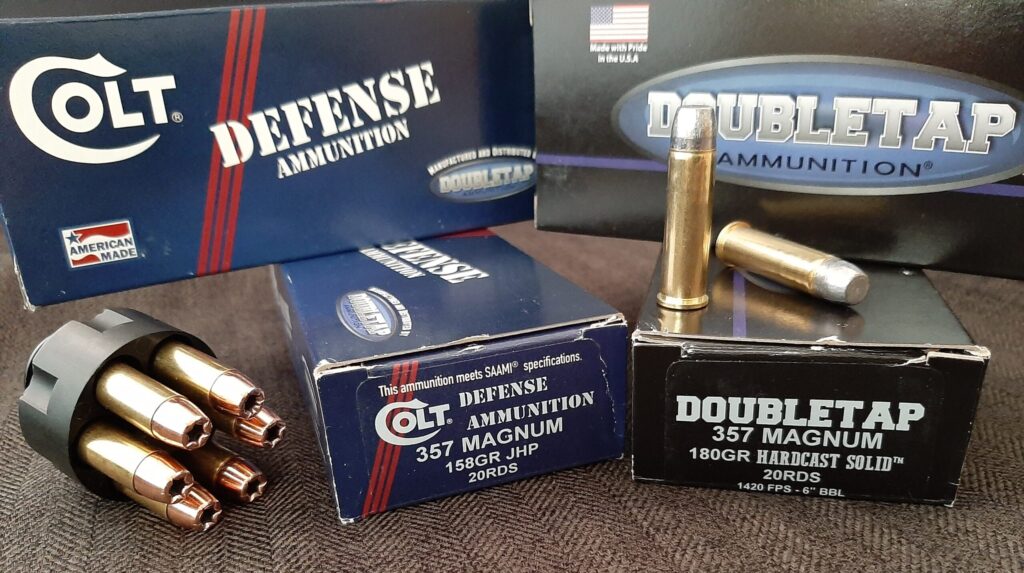
Doubletap also loads a 180 grain hard cast flat nose bullet that would excel as a hunting round or for “big critter defense”. It averaged 1311 fps and impacted to the 158 grain zero (more ballistic voodoo) at 15 yards.

I moved back to 50 yards and shot six standing offhand, holding at the lower edge of the “A” zone. I expected them to impact high at that range, but they hit in a “minute of deer vitals” spread exactly where I was holding.
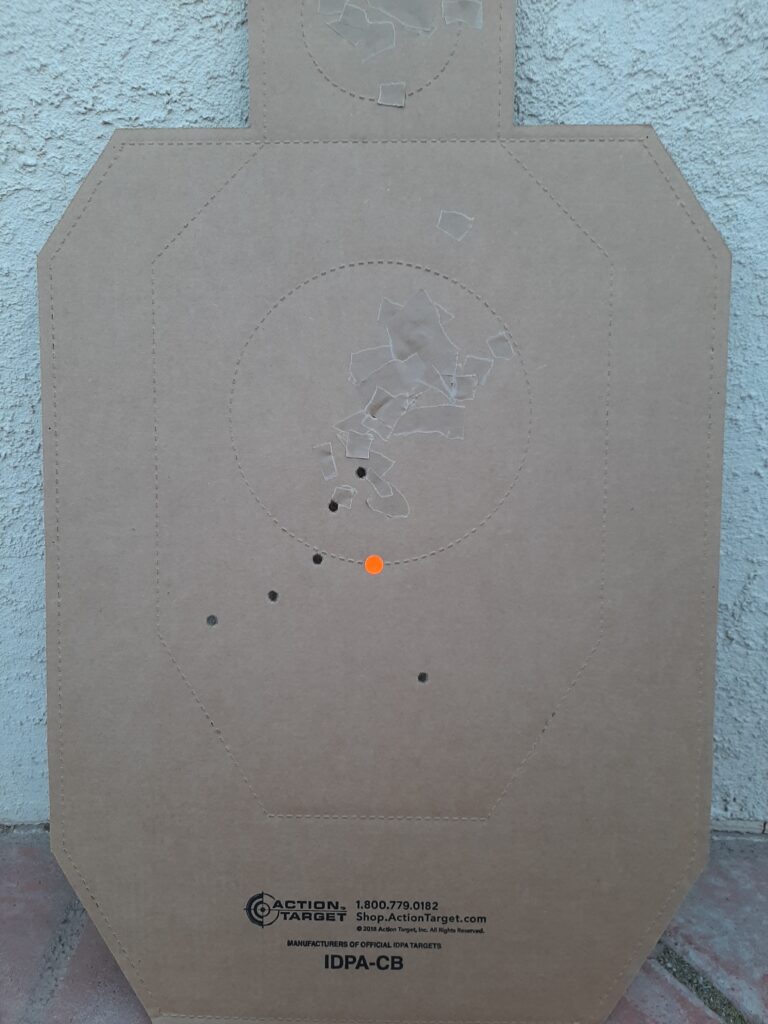
I fired five rounds and then unloaded the sixth for inspection. I did so because the long cast flat points (1.585” overall length) sat nearly flush with the front of the chamber opening. The Colt cylinder length measures 1.605”, including the protruding loaded case rim. Double Tap’s heavy roll crimp held fast; the bullet hadn’t shifted at all. Good thing, it wouldn’t take much bullet pull to tie the gun up.
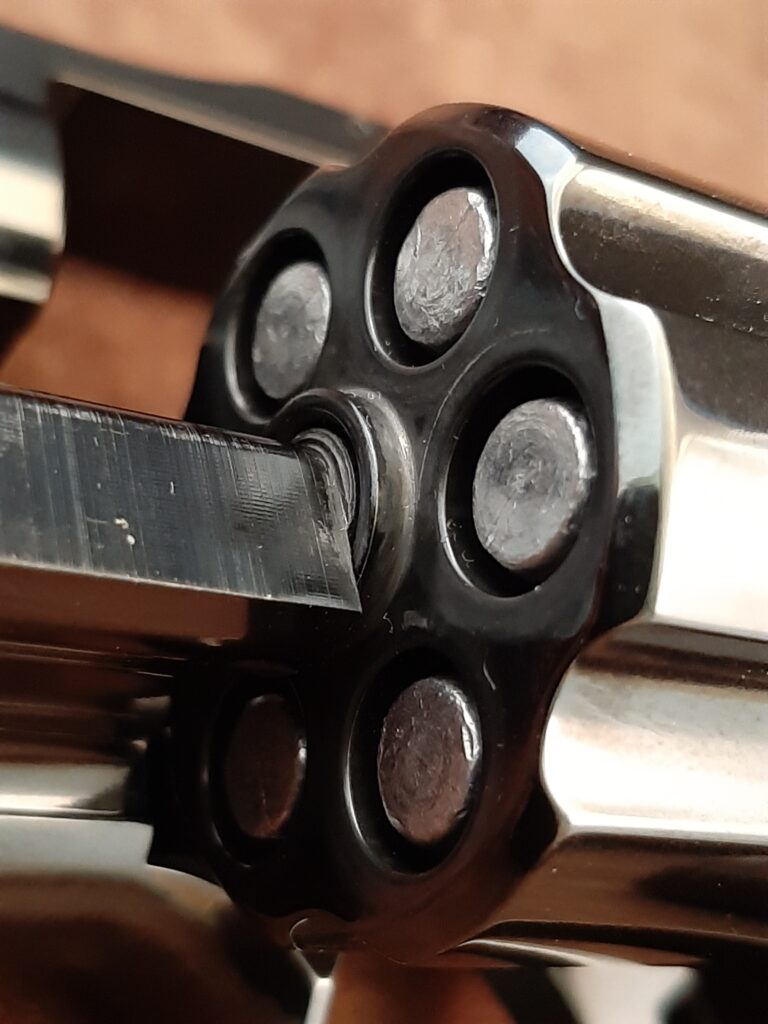
Velocities were measured on several occasions with temperatures ranging from the high thirties to the low seventies. The Python consistently yielded higher velocities than I was expecting from a revolver with a 4.25” barrel. The minimal barrel cylinder gap probably contributes to this performance.
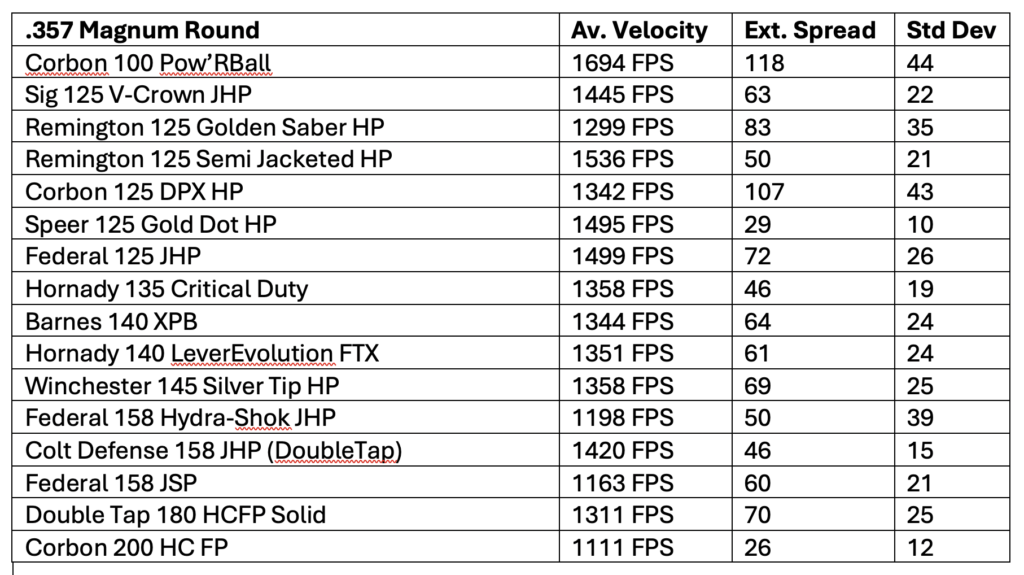

Outfitting the Python
The Python has a decent level of support gear because of its earlier run. Most holsters for the original will work with the new gun, the same with aftermarket stocks.
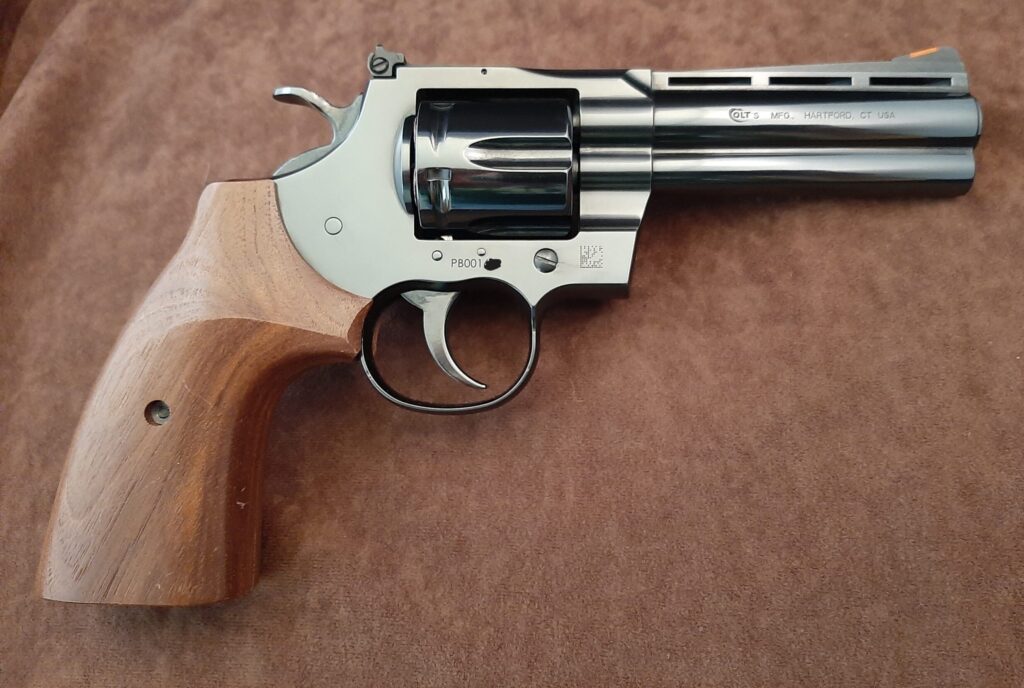
HKS manufactures a dedicated Python speedloader, and Safariland thankfully still builds a Comp 2 specifically for it. Pachmayr and 5 Star show a loader that will work with Pythons, “L” Frame Smiths, and Ruger GP-100’s. Speed Beez sells a loader for the Python for use with stocks that have a relief cut out for speedloaders; their website says it will not work with the factory stocks.
I had plenty of S&W “L” frame loaders on hand, so I tested them out. I found that some of my HKS 586 loaders would function okay, but not all of them. I had no luck with Safariland Comp 2 or 3’s or a Jet Loader, even with the stocks removed from the gun.
There are good aftermarket sight choices available, too. The red ramp would’ve suited me fine when my eyes were younger. A fiber optic or gold bead would be helpful these days and would be the only change I’d likely make to this gun.
For Score
I shot the FBI 50 round qualification cold with some Cowboy loads I’d crafted. I went over the allotted time on stage 6 (Start at a ready at seven yards, shoot four, reload and shoot four more in eight seconds). I forgot a pouch, so the HKS speedloader was wedged in my belt for the stage. I don’t know if it would’ve mattered if I had a pouch, that time limit is sporty for a revolver.
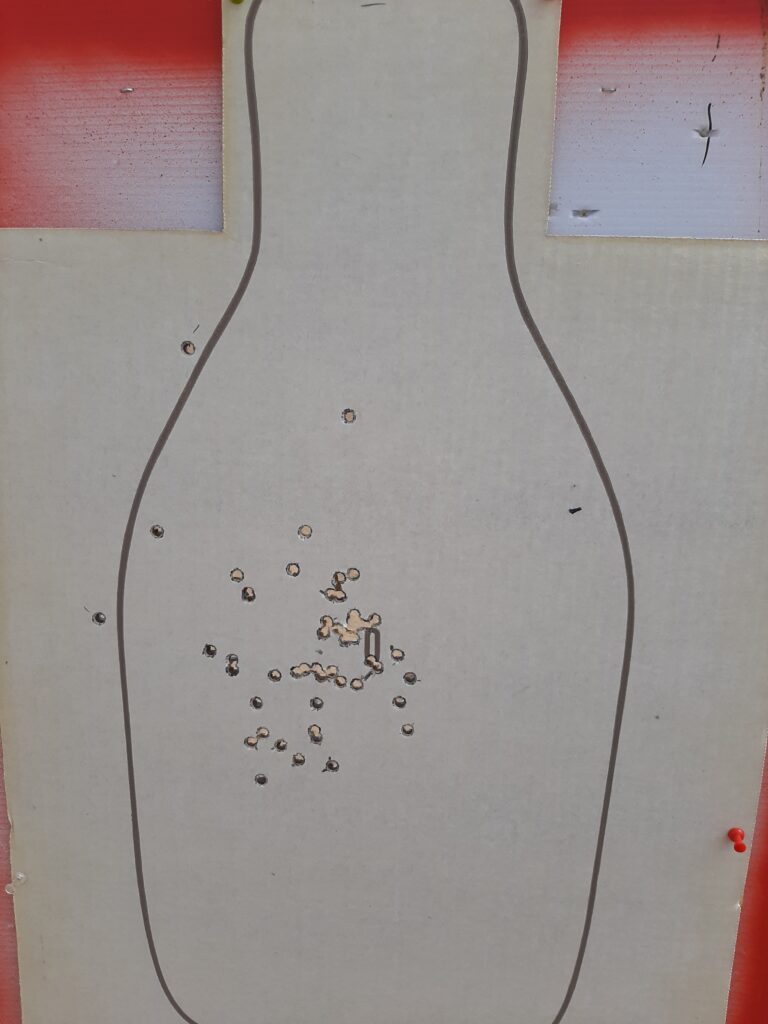
From an accuracy standpoint, the Python delivered, I lost two of the eight rounds from the 25-yard line just out left. Looking at my group, I made a slight windage adjustment to the right afterwards. The round count hadn’t loosened the set screw on the rear sight. That was the first time I’d shot that course. it won’t be the last. I’m determined to clean it with the Python.
Final Thoughts
I made several range trips with the blue Python and put a total of 540 rounds through it, with 250 of them .357 Magnums. It gave 100% ignition and performed with complete reliability.
The cylinder release and rotation working opposite of an S&W were not an impediment. I quickly got used to running it. The double action trigger felt lighter after all the shooting than when it was new, but measuring it again showed the pull weight was the same. Apparently, use had honed it.
I was astounded by the complete lack of play in the cylinder after the amount of ordnance expended. It yielded no perceptible movement, side to side or front to back. The Colt had no inkling of a “turn line” between the cylinder stop notches like a S&W will display. There was just a bit of bluing loss on the breach face behind the cylinder–otherwise the gun could pass for new.
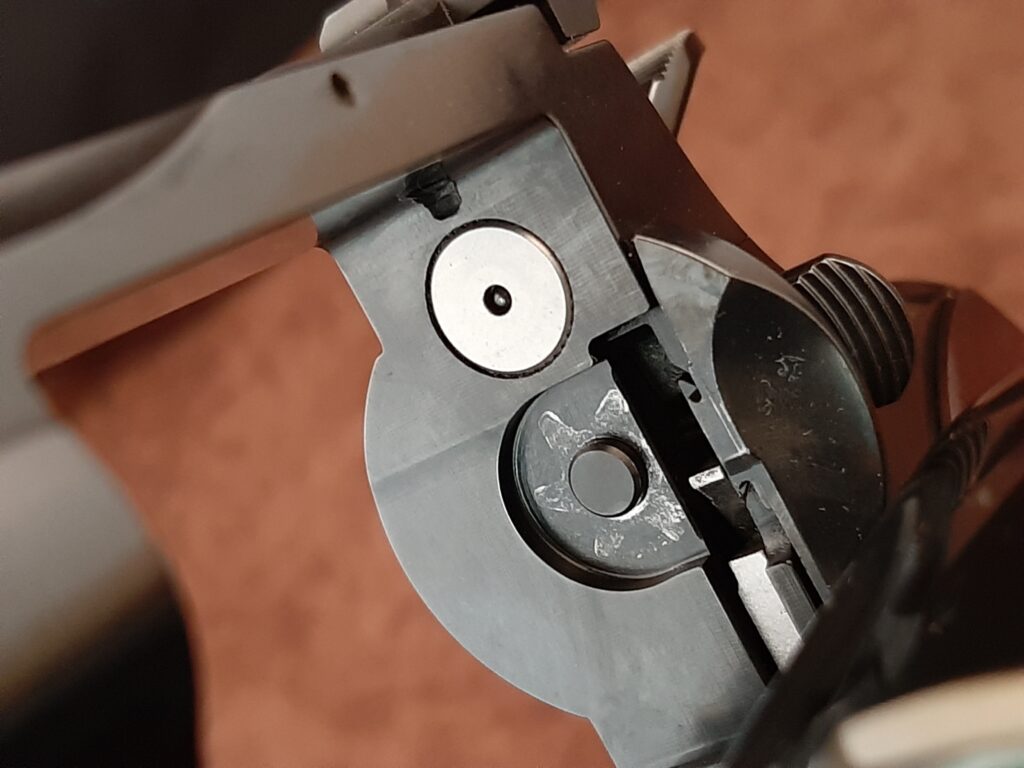
The Python with the 4.25” barrel weighed 42 ounces- it has enough mass to make it an “all day shooter” with the gnarliest of .357 Magnum rounds. The backstrap design and weight allow one to attain proficiency with these loads, instead of shooting them sparingly as lighter guns will mandate. Although a bit large and heavy for all day concealed carry in tropical climates, it would excel at most other handgun chores, like it always has. Home, vehicle, or RV defense, medium game hunting, and lower 48 state critter insurance are all good jobs for the Python. The recoil sensitive can shoot .38s instead of .357s, and the Specials can also be used for pleasurable recreational shooting. The Python would even still serve well as a duty gun if someone was radical enough to carry one in this hi-cap, red dot era.
You don’t have to worry about battering the Python into disrepair with a steady diet of Magnums like you do with some guns chambered for the .357. It’s made on advanced CNC machines from better steel than was available back in the day. The action is stronger and simpler than it was. The finish is done well, as are the stocks. It’s accurate and reliable and promises to be very durable.

They managed to keep the price reasonable, too. The MSRP is $1599.00. Even though I’m an S&W guy, spending months with this new Python has increased my respect for them. When Colt called to get it back, I gave them credit card digits instead. I decided to sell a few safe queens to finance this one–it’s a keeper.
It’s a worthy successor to a Legend. I think Colt knocked it out of the park with this gun.
*****


Kevin another perfect firearm review. It is complete, honest and detailed. The way all gun reviews should be and what RG is famous for.
Once upon a time in high school I owned a 6 inch Python. Enjoyed shooting it, all SA. When I entered LE and learned to shoot DA I gave up on Colt double action revolvers. The old Single Action Army , a match target .22 and 1911 stuck around but I became a dedicated Smith & Wesson believer revolver wise until we reached a point in the modern world where quality, craftsmanship and pride in products began to rapidly disappear.
Thank goodness for vintage Smiths and their longevity.
Sounds like the new Python is going to be very popular with Colt revolver fans. Hope this maintains that legendary manufacturer’s reputation.
Thank you for your great article.
Thank you, Tony. My first centerfire d/a revolver owned in high school was a Colt Army Special. It had the same action that Mr. Hipple described in the previous article here. That action suffered compared to a well-cared for 1970’s era S&W Model 19 I had access to. I also chose to holster an S&W when I started as a peace officer. Those older Smiths were a joy! I think the new Python will gain Colt some fans if they keep this standard of fitting and quality control. This gun is very well engineered and made; Colt cured what ailed the originals. It’s an exception to the “they don’t make them like they used to” gripe that new guns so often inspire. It’s worthy! Thank you again for your praise, Sir.
Solid and thorough review, Kevin. I’m glad to see that you’re as impressed with the new Pythons as I am, and your review helps counter some of the misguided notions that, “the new Pythons aren’t as good as the old ones.” In fact, they are improved in a number of ways, and are imo, one of the finest production revolvers being made today.
It’s great to have Colt back in the revolver space again in a big way, and doing it right.
Thank you, Hammer! I agree with your opinion that they are one of the finest production revolvers currently produced, and that Colt is doing it right. They fixed the issues that plagued the originals.
Great review! A note on using L-frame loaders in Pythons: S&W revolvers have a pin in the center of the cylinder that initiates the release of the cartridges in the Safariland Comp II and IIIs. Colt revolvers do not have the pin.
That’s why it seems like L-frame loaders will work (the cartridges align) but the release is inconsistent.
I use a Python for ICORE Classic and use Dades or Python-specific Comp IIs. There are “hacks” out there to make Comp IIIs work for Pythons, some of which can be found on YouTube. A friend’s Etsy store will soon be offering converted Comp IIIs for use in Pythons.
Hopefully Safariland will offer the Comp III for Pythons soon so all these workarounds aren’t needed. Spring assisted loaders are hard to beat in ICORE Classic, and Python shooters are looking for solutions.
Again, great review. I think Colt is making incredible revolvers and I’m glad your review confirmed what I’m experiencing with the new Python line.
Good point about the raised cylinder pin on the S&Ws that is absent on the Colts, Brent. I have found that the 5-Star loaders (L6 model) work great with the Python.
Thank you, Brent! Thank you also for the valuable info on speed loaders. You are going to have me studying my L frame Jet loaders for a work around. I can see how spring assisted loaders would be a big help in ICORE competition, and I’m with you hoping manufacturers will give us more factory options with speed loader choices. I applaud your choice of competition revolvers, Sir!
Kevin:
Readers can always count on you, Mike, Justin and other writers on this site to wring out a new-on-the market revolver and honestly report on the strong and weak features.
If I’m understanding you correctly in regard to vintage Pythons, due to their less robust lock-work firing a lot of hot .357 Magnum loads in double action mode can knock them out of time. That’s why I generally “exercise” them in single action with standard and light cowboy loads and never have had a problem.
Thank you, Spencer. I’m proud to be in such company! Thats a good way to keep that classic Python running smoothly. It should be a fine one to pass on to the next generation treated like that.
Interesting about the velocities from the 4.25” barrel, I always heard Colt deliberately undersized their barrel width just ever so slightly to increase accuracy at the cost of velocity
Tapered bore, per Colt.
Hey Elliot, I believe you are correct on Colt using a slightly tighter bore diameter than most of their competitors on the old Python. That with the twist rate had to contribute to the reputation for accuracy that Python barrels earned. I’m speculating that the tight dimensions Colt was able to get on the B/C gap with their CNC machines helped the new guns, too. Whatever they’re doing, it’s working!
Thank you for this article. I owned and carried (notice the verb tense) two different Pythons, a 2.5 and a 4-inch, in the late 70s/early 80s, and I got rid of both.
The first problem was the trigger. It was sticky and the narrow blade made it feel heavier than it was. When I dabbled in PPC shooting I never saw a Colt on the line; they went out of time more easily and were a nightmare to work on. I’ve read that the new ones have an “improved action, but this is the first time I’ve seen the new action explained. Thank you.
My other big beef was all the corners. Concealing a Python was death on clothes because the rear sight corners cut jacket linings to pieces and anraded shirts. I noticed the corners on the new one’s rear sight are beveled, so they should be easier on clothes.
Again, thank you for an informative article.
You’re sure welcome, Old 1811. It sounds like you experienced all the issues that Colt wanted to fix before releasing a new one. They definitely made the rear sight blade more carry friendly, a nice touch! I remember letting a gunsmith in the 80’s talk me into a Bo-Mar adjustable rear sight on a carry Combat Commander I had built. That pistol made sure I always had a good supply of cleaning rags (that used to be shirts).
That should read that the triggers were”stacky,” not “sticky.” @#$% autocorrect!
I was never a fan of Colt recolvers and I owned and carried the two Pythons and three different D-frames, a Detective Special, a Cobra (maybe an Agent; it was 40 years ago), and a Diamondback. The only good thing I can say is, the horsey on the side guaranteed me a good price when I dumped them.
That said, I was glad to see Colt back in the DA revolver game. Competition and choice are good things. And from what I’ve read, the new ones have fixed a lot of the things I didn’t like.
Also “abraded,” not “anraded.” I can either blame that on autocorrect or learn to proofread.
Maybe i’m spoiled from my first revolver being a Colt 3-5-7 but to me Smiths feel backwards; the cylinder release pushes the revolver away from your palm instead of into it and the cylinder turns counterclockwise. Tomaytoe, tomawtoe I guess.
Also, someone reading the comments section of your articles sniped my idea to name a new revolver “Roscoe”, Heritage announced their .38 special Roscoe revolver at Shotshow. I look forward to your review of it and also the new Taurus Executive Grade 692 here in the near future.
Hey Jeb, I’ll admit that the controls on that Python work pretty well when you get used to them. Yup, Heritage saw a good name and jumped on it! We will get to work on those two asap, Sir!
Impeccable writing, as always. Thorough, practical data. Well done!
Thank you, Anner! I enjoyed evaluating this Python a lot- I’m glad you got something out of it.
Kevin, kudos on finding a forever home for a lost and wandering Python (not the Burmese species). They were, as you pointed out, considered the Cadillac of police service revolvers. Those who carried them on duty were usually serious about their sidearms.
However, the old Colts had a horrible double action trigger, and as you noted, were a bee itch to retune. Those looking at the picture you provided of the mainspring shows the dramatic geometry change of that spring. For those not familiar with the ancient Colt mainspring, it was, quite literally, crimped at its base where it was inserted into the grip frame, and resulted in most of the ‘spring’ effect taking place about half way up from the base to the hammer link. The new design, shown, allows the entire top half of the spring to tension the hammer, much like the S&W leaf spring.
The old Colt bolt stop was ridiculously small, and was actually a lever that was screwed into the frame at about half its length. A cam at the opposite end engaged the trigger return bar which activated the bolt stop as the trigger was being drawn back. At the same time, the hammer block was a two piece mechanism that had to have been the product of someone’s nightmare. It was part of a lockwork design that was overly complicated, required hand fitting, and probably necessitated some mind altering substances for its design and to make it work properly.
The 1:14 inch rifling twist was Colt’s golden point, and one which I have yet to figure out why S&W and Ruger, among others, had not adopted. It over stablizes flyweight bullets for sure, but the heavier business loads were delivered with great accuracy. A number of serious PPC shooters had gunsmiths install Python barrels on S&W frames (Smython, or Smolt) giving amazing results with wadcutter loads.
On different occasions from the 1970s to the mid 1990s, I owned four Pythons, two blued, two nickled, and got rid of all of them. Compared to the S&W, the only thing the old Python offered was a superb barrel attached to a nightmare.
One star attribute the Colt has comes if you’re gaming the clock, and that’s the cylinder release. When the Colt Dome latch is drawn back with your shooting thumb, you should be able to turn the gun to the port side and the cylinder should drop free. Then with the left hand, pop the empties out, speed loader/strip fresh rounds and roll the cylinder back in.
The new Colt actions have a considerable amount of Smith & Wesson influence hidden under that sideplate – imitation is the sincerest form of flattery I’m told. Combined with a stronger frame and metallurgy, it promises to be a brute of a .357 platform. Now try and get your S&W family to play nice with the new Colt . . .
I felt it was my duty to provide a forever home for it. 🙂 Thank you for lending your insight and expertise on the old action! I shot those 158 gr. .357’s prone from 50 and that was the first thing I thought of when I looked at the target. This Python just cleaned the prone portion of stage 3 of a 1500 course, with a 4.25″ barrel and magnum ammo… The whole Smython thing suddenly made sense to me! You rightfully point out that Colt did what was needed to strengthen the Python to live long and prosper with full house magnums. My old Model 19 has already complained that the Python is strutting around, and striking Schwarzenegger poses in the gun safe…
Ouch! That bottom line.
Still, sounds like there’s hope for Colt after all. Are they still part of CZ, and is that driving their QC?
The improvements appear to be genuine, not cost-driven, including a rear sight that is more CCW-friendly. I’m more than familiar with the weak points in the original action after almost 5 decades of Colt DA ownership, and the pic that is most relevant is that of the mainspring. It’s heavier, yes, but more importantly, it’s no longer a V, but a U. Cock or cycle a “V” action sans grips and watch what happens when the spring is compressed–against itself!
I don’t know how readily Colt will part with, well, parts. If I got my hands on a new Python I’d be looking to bob the hammer, smooth the trigger, round the rear sight blade and fit a tritium front, but not on the original parts.
Now if they’ll bring out a 2.5″ I can erase the trauma of having let my original go in a trade.
Colt is still part of the CZ Group, as is Dan Wesson.
Have you felt the trigger on a new Python? I’m honestly not sure how much smoother mine could really be.
And yeah, they introduced a 2.5″ version earlier this year. 😉
Smooth as in delete the grooves and radius the back edges of the trigger blade. Got a big hand and long fingers, and that’s what works for me on OPs and my 3-5-7.
Viejo, that’s the only work I’ve had done on my 2020 Python—have the trigger face polished and rounded. I like it much better that way.
Colt had already done great things with their new revolver designs before the CZ deal went through. In fact, it was Colt’s success in this area that attracted interest from CZ to begin with.
Frankly, it’s the revolvers which have been keeping the lights on at Colt for the last half-dozen years, and keeping them out of bankruptcy. Colt has struggled with finances for a long time, but the new (2017+) revolvers have been very successful and have made Colt a worthy investment for CZ.
The infusion of CZ funds has allowed Colt to stay focused on design and production quality, and we have benefited from that with new introductions like this blue (2024) Python, but Paul Spitale and crew were already making great guns before the Czechs got inolved.
Thanks, Kevin! By the way, the photo work on this review is excellent. You’ve mastered good lighting and accessory placement in photos.
Hammer, I haven’t seen a 5-Star in person. Thank you.
Thank you for the kind word on my pictures, Brent. A man that’s like my brother is a really talented photographer, he has a sniper’s eye for detail and has taught me a little about light. Sometimes I just get lucky, too! I appreciate you noticing that!
Hey VL, I believe they are still part of CZ. I don’t know if that’s driving it, but my impression is that Colt is committed to maintaining QC and increasing revolver production. Let’s hope they keep succeeding! Thanks for lending your experience on the old ones, too. I see that Colt is offering a 2.5″ Python in matte stainless, so…
Kevin,
Great review which brought back good memories. When I became a policeman in 1989 a lot of us in the academy wanted to carry a Python. We were really cool, but without the Python on our belt how would anyone know…the range master worked hard to dissuade anyone from carrying a Python . He said it would go out of time every 250 rounds (that was accurate) and there was only one gunsmith in town who could fix it, and he was old and in poor health. It’s a shame we can’t carry Pythons any more. It sounds like Colt may have made them better (and I’ll still cool no matter what some of my loved ones say).
Thanks, BC. I went to the academy in 1988 and there was a dude in our class from Tucumcari PD that carried a Python. Immediate street cred amongst his peers. I thought he was really cool for carrying that Python (plus, his hair was perfect!), I know what you mean. Colt IS making them better, and you’re still cool! 🙂
An excellent, and in-depth review. Great photos too. I think there are only three complaints I have with the new blued Pythons. First, and most egregiously, I don’t agree with Colt’s decision to add a third barrel vent on the 4.25″ blued model. It looks overly crowded to me, it doesn’t match the looks of the vintage or new stainless models, and it seems like an unnecessary, highly subjective alteration to a legacy design that was specifically prized for its looks. It annoyed me that Colt touted their decision to use gold medallions in the grips on this blued model to remain traditional, and then completely glossed over the added vent in their reveal video.
I find Altamont grips much too thin in general for continuous magnum shooting. And I wish that Colt would do something about shoring up or redesigning the rear sight. At a $1600 MSRP the first recommendation shouldn’t be “go find a Wilson Combat rear sight.”
I was looking forward to purchasing a 4.25″ blued model when they were announced, but I can’t get past that extra vent. I’ll hopefully be first in line if they offer a 2.5″ or 3″ blued model though. I’m most certainly thrilled to see a return of another polished blue finish option in the market. The Heritage Arms Roscoe is now available with one, and while it’s not nearly as impressive as the Colt’s, it’s a step in the right direction IMO.
Thanks, Zach. You’re not the first person I’ve heard bring up the three barrel vents. As a Smith guy, I didn’t even notice the difference. The vents don’t have any effect on functionality that I can discern, but they differ from the original. It is interesting that Colt changed them, if anyone knows what the thought process was, please advise. The Altamont grips are a good all-around grip, but a second set for heavy use is a good idea. I scored a pair of the old camouflage Pachmayr Presentation grips to use on the Python if I carry it on a hunt. I’ve bought many medium and large frame S&W revolvers, none of which retain the factory target stocks for actual use. I find the Colt Altamont grips to be more user friendly than the issue stocks on S&W’s. I found the factory rear sight to be serviceable, I didn’t feel the need to replace it. I did order a Wilson fiber optic front sight that’s more agreeable with my antique eyeballs. I’m pleased that there’s the aftermarket support to change things that don’t work for us, and I hope Colt builds you that shorter barreled one with a blue finish!
I bought a 6” new Python a few years ago and commonly use handloads with a cast 170 gr Keith SWC at warp factor 3. I absolutely love the gun . . . And (like Keith) I don’t like the grip frame. It always rolls up in my hand unlike a S&W. But I’m old and I have a large box of grips that have coalesced over the decades. I put on a set of Pachmayr Presentation grips and all is well.
Brett, hard to argue with that bullet at any reasonable velocity! As you mentioned, there are ways to deal with that grip frame shape for heavy loaded magnums. Cheers.
Kevin,
Nice writeup, as usual. There was a time in the early 1980s when I could afford the Python (and four-inch MkIII Trooper or two-inch Lawman MK III), but found the DA trigger reach a little long for my medium-sized digits, so I became a S&W K-frame and Ruger Service-Six man. While other reintroduced Colts leave me cold, the new Python’s rear sight seems an significant improvement over the the old Eliason and the easily replaced front sight rivals that on the GP100.
Thanks for another high quality deep dive sort of article RevolverGuy is known for.
Hey Michael, thank you. I understand the hardware choices you made back then. The new Python’s rear sight is definitely a big step up! That’s a very good point you made about the front sight, I should have made a bigger deal about it. Colt has made it extremely simple to swap the front sight on its new Python, and most of their other revolvers. As you said, Ruger does so on the GP100. You have to carefully shop for that feature with S&W L and N frame revolvers; they only make a few that use the “DX” style front sight that make swapping sights an easy task. This should be a standard feature on modern service revolvers. Thanks again for your kind words, I’m glad you found it fit to read.
Hey, thanks for the write-up. I’ve normally avoided Colts because of the price tag and the cylinder release, but after the disappointment that was the 586 Classic I had recently, I think I’d be open to giving Colt a try now.
That said, I’m not sure I’m ready to commit to another .357 Magnum revolver. Part of my disappointment with the 586 Classic was how uncomfortable it was for me to shoot with pretty much any .357 load; even with Pachmayr Presentation grips. I don’t know if I want to bother with that cartridge again.
If Colt wants to make a variant of the Python in .327 Federal Magnum, then I’d certainly consider it. I’d have to get one with a 6″ barrel, because I’ve fallen in love with that barrel length for full-size revolvers.
Axel brought up an interesting variation – the Python in .327 Magnum. There are a host of venomous snakes to lend names to future Colt snake guns – Taipan, Black Mamba, Mojave Rattler, as samples. Alas, a lot of venomous candidates, but the names probably won’t go well on revolvers: The Chinese Copperhead, Blue Krait, Blue Malayan Coral, the list is extensive.
As for the rib venting, I would agree that the three vents make the profile much too busy. It is bad enough that the industry had to kneel to Canadian regulations and impose the 4.25 inch barrel on the rest of us; that said, the traditional two vents on the four inch and three vents on the six inch are much better balanced.
Next up I half expect someone like Hamilton Bowen to offer conversions of the new Colts from the 4.25 inch back to 4 inch barrels so all our old gun leather will work.
You’re welcome, Axel. I hate to hear that your experience was so negative with that 586 Classic. The Python’s felt recoil was less (with all rounds fired) for me as compared to an L frame. I’m wondering if you ran any “mid-range” .357 stuff through yours, like that 125 gr. Remington Golden Saber? It was very manageable through the Colt. I was very impressed with the performance of the .38 +P stuff I ran through it, too. That Underwood SWC HP gave impressive velocity for a 158 gr. bullet, I wouldn’t hesitate to use it for defensive purposes. I’d be really surprised if Colt chambered a Python in .327 Federal. Maybe they would consider a Diamondback though? A 6″ .327 Diamondback would have enough mass to be pleasant shooting; it would strike fear in the hearts of varmints! S. Bond has given Colt plenty of fodder for new names if they don’t want to recycle the Diamondback moniker!
Kevin,
I have to ask:
What are the grips on your S&W? I do not recognize them.
Hey CM, the grips on the 686 are Macassar Ebony made by Dwayne Worley. He is at least temporarily retired, so getting him to craft a pair right now isn’t an option. Apologies on that! If you want to see more of his work, the first article I wrote for RG in October 2020 was about Worley’s grips. He is a master.
I like Worley’s grips. They look like they’ve seen some use and are still sharp looking. I hope you get a lot more use out of them. Some of the younger generation need to understand that there is nothing wrong with having some style.
Thanks BC! Worley wore that set on his carry gun for a few years, and then gifted them to me. I have had them on my 686 for more than a few decades and I’ve never spared them the bumps and bruises, because that’s what Worley told me to do with them. They have some honest wear, but as you noticed, they look better now than when they were new.
Well done, Kevin. Your take on the new Python was well-stated, fair, and detailed, as always. I must confess to having a definite lack of enthusiasm for the Colt Python through the years, having been around one that was very troublesome. That particular example was badly out of time, and spit lead everywhere when fired. It seemed no one could help it either…after taking it to two different local gunsmiths, we gladly bid good riddance to it at a very discounted price. (Where’s Clifford Hugg when you need him?) We all associated it with the ‘hot girlfriend’ who everyone wants, but was impossible to live with afterward.
All of the hoopla over the new Python has left me cold…I want to like it, but I remember the horrible experience we had from the past. To read Your honest and detailed write-up, I think this latest version is worth a good second look! Thanks again, Kevin!
Thank you very much, Kevin. Experiences like the one you had matter. I’m glad that Colt made the effort to fix known issues before releasing the new generation Python. From what I’ve seen with this new one, it is worth a second look. Colt had to fix the problems because there doesn’t seem to be many like Clifford Hugg around anymore, huh? Your analogy about that old Python made me chuckle. Colt is doing their part to prove that there are still pretty girls out there that like to hunt and shoot, work hard, clean their own birds, etc! 🙂
That blue Colt Python is a beautiful revolver! A fellow officer in my precinct allow me to inspect his new Python back in 1983. My local gun dealer tempted me with a pristine, used Python a few months ago.
I’m not sure how many days I have left on this planet but I’d sure like to own and shoot a Colt Python before my time is up!
Great in depth article- keep them coming!
Thank you, Opa. I distinctly remember seeing a local police officer in my hometown respond to a vagrant call at an arcade in 1984, while I was still in high school. I can see his immaculate appearance like it was yesterday. His bearing was entirely professional, it matched his appearance. The opening photo of this story shows a “belly of alligator” Sam Browne like the one he was wearing that day with a blue Python in his holster. He made quite an impression on me; in fact, he helped steer the course of my adult life. he ended up being the first Chief I worked for as a police officer, I was very fortunate to know him and experience his good leadership. He took a chance and hired me when I was a very young fellow to do a man’s job. His name was Raymond B. Chambers- he is the first person I think of when I see a Colt Python. I hope you get the chance to own and shoot one in the days still promised to you, Sir! Thanks again.
As soon as I saw videos of the blued Python in videos of the 2024 Shot Show I called my former manager at the LGS where I used to work. I made an appointment and brought a barely used gun to trade to satisfy the 50% down needed to place the order.
I was very disappointed when the stainless Pythons were introduced and issues cropped up as content providers on YT showed issues on their revolvers. Of course those issues didn’t plague all owners but enough for my LGS to notice a pause of customers interest.
Fast forward to 2024 and my order was placed. When it arrived I wasn’t google eyes like most buyers. I took the time to inspect and dry fire the revolver. If there were any issues I wouldn’t take delivery and my LGS would refund my deposit.
After a thorough cleaning I took to the range with my 4″ 586 no dash and burned through two boxes of 158gr SJHP one each revolver so that I could compare performance.
I had OEM target hammer and target trigger installed on the 586 which, in my view allowed me to better handle the recoil. The Python has a narrower trigger with deep serration while the target trigger on the 586 was so much wider with shallow serrations. After a few rounds in the snake gun my trigger finger felt the recoil through those deep serrations.
Not a big deal but very noticeable.
At 10 yards I was able to keep it in the 9/10 ring without issue.
I previously owned a 1970s blued 4″ Python that was quite the looker. However a gun with hand fitted parts is better as a safe queen than a daily shooter. Additionally, my gunsmith whom I’ve done business with for 20 years cautioned me about owning/shooting vintage colt snake guns. Parts are not easy to source and he will not work on them. The companies and guys that do work on them are few and far between.
Cylinder and Frame is one of the few that will work on vintage Colt revolvers. As my smith mentioned parts are hard to source and the guys that work in them are retired and or dead.
I sold that Python on GB and easily made a tidy profit that was quickly stashed away.
The Galco Combat Master holster works well with the Python and the 586. I am glad that this will fit both revolvers so that I don’t have to buy two of everything.
Hey Mr. Saiz, I’m assuming by your comments that you held on to the new blue Python that you ordered. I hope it meets your expectations. If mine is any indication, it should give you dependable service. I’m also assuming you are referring to Cylinder and Slide, I am not familiar with a gunsmithing business hanging the shingle “Cylinder and Frame” out there. Good deal that your Galco CM works with both! I’ve had similar good fortune with a few L frame holster I have lying around here.
I’m in agreement on the trigger on the new Python, and wish it didn’t have the grooves! I had my gunsmith polish them out on mine and it feels much better. As Kevin noted in his article, the new 2020 Python is more robust than the old design, and should give you many decades of service without the need for re-timing.
I had Doug Phillips hone out the throats of my six inch new python (not needed with any Colt OMM that I’ve ever owned) to get them to be within .0005 of each other and then Frank Glenn did a single action trigger job so that anyone really serious about accuracy, had a chance of developing good trigger control, and put in my Ransom Rest. This revolver’s heritage was not just as the world’s best revolver but it also had a factory accuracy requirement. It did “almost as well” as my OMM’s and model 14’s but not quite. The slightly large ten shot groups (3.25 inch ) of the new Python (compared to 2.5 for the other classic target revolvers) could just be statistical variance since my conclusions were based on just three, ten shot groups with a classic accuracy load that most bullseye shooters use. I did need to custom size the bullets because cylinder throats vary and I wanted to try to use the absolute most accurate load for each particular revolver. They are all close but if one wishes to have the absolute most accurate fifty yard gun, I think the award STILL goes to any of the five issues of the Colt Officers Model/Match Target, though by a very slim margin, followed too closely to care by the Smith 14/K38.
Ed, thanks for the detailed report and comparison. Sounds like you’ve got some wonderful smiths working on that gun, and it’s performing well. Happy to hear it!